THE ART ISSUE







I DON’T EXACTLY RECALL WHEN I FELL IN LOVE WITH ART, BUT IT’S always been a part of my life. I grew up in a home filled with art books, paintings, and parents who insisted that I knew the difference between Monet and Manet by the time I was 12. When my family left the Soviet Union, we spent six months in Italy as we waited for our entry visas to Australia. It was a formative time, cementing my awe of art and artists. One glimpse inside St. Mark’s Basilica, one peek at the Sistine Chapel, one eyeful of the chiseled contours of David, and it was impossible to imagine a world where such things didn’t get created. Thankfully, we don’t have to.
As always, what you have in your hands is just a small sampling, a snapshot, of the many stories of art and artists in Indianapolis and its environs. Speaking of beyond, if you haven’t been to Fort Wayne recently, please make a point to journey there for a day of exploring their public art trail and profusion of murals.
AND NOW, TWO UPDATES FOR PATTERN FANS IN THE KNOW:
FIRST, YOU MAY NOTICE THAT THE COVER PRICE OF THE MAGAZINE HAS BEEN BUMPED TO $20. This hike reflects the increasing costs of…well, everything...but also reflects what we see as the mag’s mounting value to this city, state, and region. The good news is that if you subscribe, the price increase will have no bearing on you at all, as the price of an annual subscription will remain at $30. #winning
AND SECONDLY, WE’RE UPDATING THE MAGAZINE’S TAGLINE. OUR ORIGINAL TAGLINE, “FASHIONING A community,” was and remains central to our ethos of building an ecosystem of creatives. That said, over the past twelve years our community has continued to grow, and we found ourselves spending more and more time on helping creatives in all fields do what they do best—create! The new tagline “We help people create,” will serve as a reminder to all of us about why PATTERN exists.
I’M SO GRATEFUL FOR ANOTHER OPPORTUNITY TO CELEBRATE INDIANA’S ARTMAKING PEOPLE WITH ALL of you. My hope is that once you’ve perused this issue, you’ll be inspired to seek out the creative hotspots and allow yourself to be stoked by the myriad of styles and flavors of art available in Indianapolis and beyond.
THANKS FOR READING AND SUPPORTING!
P.O.
POLINA OSHEROV EDITOR-IN-CHIEF

BRAND PARTNERSHIPS
info@patternindy.com
DISTRIBUTION
Contact us at info@patternindy.com to stock PATTERN magazine.
Printed by Fineline Printing, Indianapolis, IN USA
PATTERN Magazine
ISSN 2326-6449

Proudly made in Indianapolis, Indiana
PATTERN DIGITAL
Managing Editors
Cory Cathcart
Katie Freeman
BOARD OF DIRECTORS
Melanie Allen
Michael Ault
Alan Bacon
Isaac Bamgbose
Casey Cawthon
Michelle Griffith
Freddie Lockett
Lindsey Macyauski
NaShara Mitchell
Yemisi Sanni
Sara Savu
Micah Smith
Barry Wormser
Ace Yakey
SUBSCRIPTION
Visit patternindy.com/subscribe
Back issues, permissions, reprints info@patternindy.com
FASHIONING A COMMUNITY

EDITORIAL
Editor & Creative Director
Polina Osherov
Design Director Emeritus
Kathy Davis
Design Director

Lindsay Hadley
Managing Editors
Cory Cathcart
Katie Freeman
Editorial Intern
Destany Long
Copy Editor
Anne Laker
DESIGNERS
Carrie Kelb
John Ilang-Ilang
PHOTOGRAPHERS
Jennifer Wilson-Bibbs
Wil Foster
Kelsey Matthias
Jacob Moran
Polina Osherov
Andre Portee
Liam Rogers
Leo Soyfer
Jeanie Stehr
Brooke Taylor
Photography Intern
Cecil Mella
WRITERS
Milan Ball
Philip Barcio
Alexa Carr
Cory Cathcart
Anne Laker
Shauta Marsh
Richard McCoy
Polina Osherov
Liam Rogers
Adam Thies
Jenny Walton
Emily Wray
PATTERN IS GRATEFUL TO THE FOLLOWING FUNDERS AND PARTNERS FOR THEIR SUPPORT:

PATTERN ISSUE NO. 22
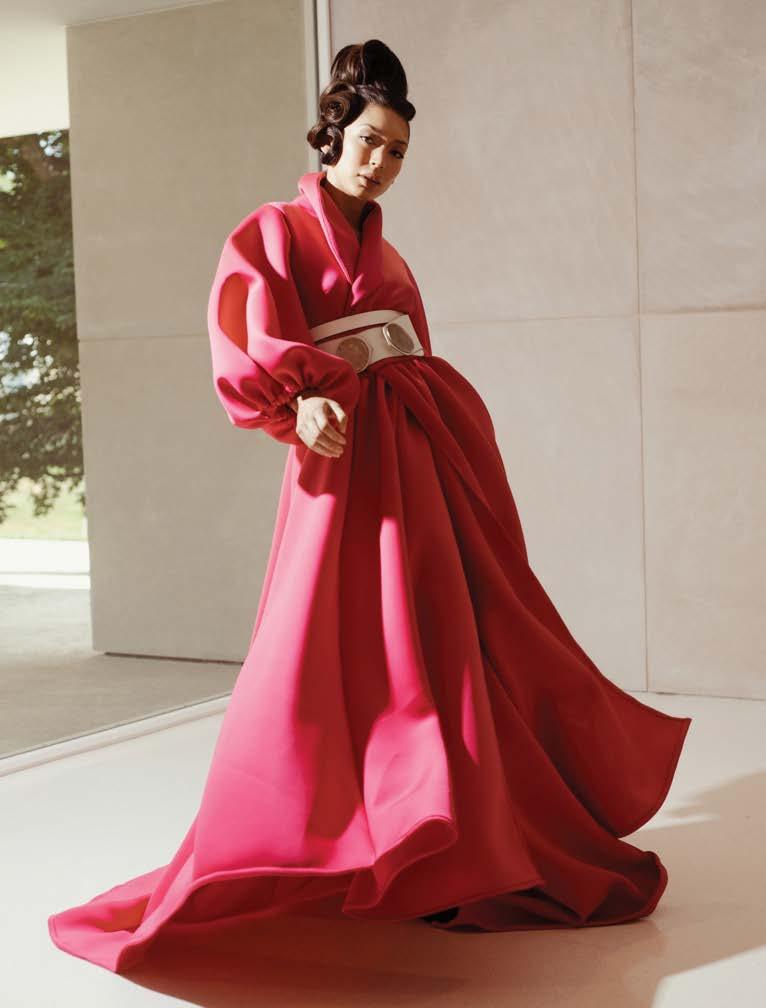
patternindy.com
EDITOR’S LETTER, 2 CONTRIBUTORS, 8
ART IS THE QUESTION WITH ARTUR SILVA AND SAMUEL LEVI JONES, 20
LONG LIVE FIRST FRIDAY, 24
MEET THE ARTISTS, 31
CASEY ROBERTS
TAYLOR SMITH
TOM DAY
JAY PARNELL
LYNDY BAZILE
BEATRIZ VASQUEZ
KEEP GOING TO 10 EAST, 50
Q+A JULIAN JONES, 58
FORT WAYNE OVERFLOW, 62
Q+A MARK BRASTER, 66
THE JUBILANT JOY OF JANAY, 78
NICKEL FOR YOUR THOUGHTS, 92
MEXICAN ART IN FLUX, 94
Q+A MÓYÒSÓRÈ MARTINS, 98
NASREEN KHAN, 102
ART IS THE QUESTION WITH WALTER LOBYN
HAMILTON AND DANICIA MONÉT MALONE, 106
BLOCKCHAIN OR IT DIDN’T HAPPEN, 110





I would paint giant, hyperrealistic murals on both sides of the OneAmerica Tower, recreating and restoring the view down Indiana Avenue through to Monument Circle that once existed in our city.
SARAH URIST GREEN is a curator and art educator seeking to demystify the worlds of art, artists, and museums for wide audiences. She is consulting producer of Ours Poetica, a YouTube series brought to you by the Poetry Foundation that captures the experience of holding a poem in your hands and listening as it’s read aloud. Green is also author of the book You Are an Artist, an outgrowth of the educational web series The Art Assignment, which Green developed in partnership with PBS. A former curator of contemporary art at the Indianapolis Museum of Art, Green holds a bachelor of arts from Northwestern University and a master of arts in modern art history from Columbia University.
theartassignment.com
@theartassignment
I want a giant mural painted by Shadé Bell on one of the huge buildings downtown where everyone can see and experience it.
LEO SOYFER is a commercial portrait and fashion photographer, with a degree in Marketing from the University of Indianapolis. He has previously worked closely with PATTERN magazine, and has even printed his own small magazine, titled KPACOTA (krasoh-tah). In his free time, Leo enjoys playing piano and producing hip-hop music.
leosoyfer.com
l_soyfer
If I could paint a mural on a building, it would be a painting of influential photographers of the past. This is so that people will know the history of photographs and how vital it actually is inside and outside of the art world.
CECIL MELLA is a fashion and portrait photographer based in Chicago and is a past intern for PATTERN magazine. He has been studying and photographing for seven years. He is interested in photographing subjects in colorful backdrops and lighting to help outfits and models stand out.


cecilmella.com
cecilmellaphoto
I would choose to have a mural painted on the Salesforce building. With Salesforce being the tallest building in downtown Indianapolis, I think it would make a good statement by showing that Indianapolis is more creative than people may think.
DESTANY LONG is a freelance writer, born and raised in the heart of Indianapolis. Since she was a child, Destany has enjoyed bringing her vivid ideas to life through her writing. Her ideal career plan is to work for an online music publication writing stories about notable musicians. When she’s not glued to her laptop, you can most likely find her listening to music, hanging out with friends, and trying new local eateries.
desquisite
If I could paint a mural, it would be to restore the Roland Hobart mural on Delaware St, across from the City County Building that was originally created in 1973. If it were restored on the two walls it would easily be the best public artwork in the city.
RICHARD MCCOY is the founding Executive Director of Landmark Columbus Foundation, a non-profit organization dedicated to caring for, celebrating, and advancing the world-renown cultural heritage of Columbus, Indiana. He has a long history of creating unique solutions to complex cultural heritage challenges and occasionally writes about arts culture.
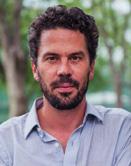
richardmccoy richardmccoy
I’d love to see a mural on The Pyramids. Such a largescale piece would be hard to miss, drawing much-needed attention to the arts on the north side!
KATIE FREEMAN is a Creative Fellow and Managing Editor at PATTERN. She can often be found in a state of overcaffeination, click-clacking away on her laptop and enjoying some variety of spicy snack.
notkatiefreeman

The mural I would choose would be of Gordon Parks the photographer. I would have it painted on a building in Fountain Square–the most visible building–not in an alley. Gordon captured the stories of social injustice through photojournalism.
JENNIFER WILSON-BIBBS of Life Through
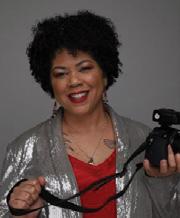
Jenns Eyes Photography is a local Indiana photographer. She started photographing professionally in 2018 discovering that she had a passion for capturing her vision of what she sees through her eyes. She has photographed some amazing people and places throughout her journey. She has a way of bringing comfort to her photoshoots and bringing out the best in her subjects.
lifethroughjennseyes.com
lifethroughjennseyes

 PHOTOGRAPHY BY JEANIE STEHR
STYLE BY MACKIE SCHROETER
HAIR BY CAROLYN CINA
MAKEUP BY COREY CRYSLER
MODEL: ALYSSA L
PHOTOGRAPHY BY JEANIE STEHR
STYLE BY MACKIE SCHROETER
HAIR BY CAROLYN CINA
MAKEUP BY COREY CRYSLER
MODEL: ALYSSA L
 BLACK FAUX LEATHER COAT STAND STUDIO RHINESTONE FISHNET TIGHTS NASTY GAL BLACK PLATFORM HEELS ASOS DESIGN
BLACK FAUX LEATHER COAT STAND STUDIO RHINESTONE FISHNET TIGHTS NASTY GAL BLACK PLATFORM HEELS ASOS DESIGN


 RED SEQUIN DRESS SOLACE LONDON BLACK PLATFORM HEELS ASOS DESIGN
RED SEQUIN DRESS SOLACE LONDON BLACK PLATFORM HEELS ASOS DESIGN




 GREEN TRENCH COAT NASTY GAL BLACK KNEE HIGH BOOTS STYLIST OWNED
LONG SLEEVE GREEN DRESS ZARA
GREEN TRENCH COAT NASTY GAL BLACK KNEE HIGH BOOTS STYLIST OWNED
LONG SLEEVE GREEN DRESS ZARA
ARTISTS SAMUEL LEVI JONES AND ARTUR SILVA GO DEEP ON USING ART TO QUESTION ALL THINGS.
PHOTOGRAPHY BY POLINA OSHEROV

SAMUEL LEVI JONES is an Indianapolisbased multidisciplinary artist born and raised in Marion, Indiana. His work explores power structures and equality through deconstructing historical objects and using them to create his art. Jones specifically uses the pieces that expose flaws in history and what authorities have declared “truth.” He is currently preparing to exhibit at Galerie Lelong in New York and Paris and a residency in New York at Dieu Donné.
ARTUR SILVA: Hi! Great to see you. What’s new with you?
SAMUEL LEVI JONES: This past week, I started an artist residence at Indiana University in Bloomington. I’m going into it open-minded–not sure what I will create or research. One of the things that I’ve picked up on is that the departments are extremely siloed. An example is how the museum has an exhibition right now with a number of artworks by artists of color, yet the African Cultural Center, located next door, didn’t know about the programming and vice versa.
I'm wanting to have conversations about disrupting that, building larger community, and breaking down those walls.
AS: I’m one hundred percent with you. This vision in the art schools that programs are siloed. I think Bauhaus was way ahead of their time in the early part of the twentieth century thinking about a school that has no walls. An architect is also learning about film, and a painter is learning about music. We need that back.
SLJ: Yeah. I think a part of institutions is that they've been around so long that people tend to think everything must be okay, because if not, how do they still exist? Also, even if you are involved in something, there’s nothing wrong with being critical of it. It’s a job of the participants to be critical of that space in order for it to grow and expand.
AS: Absolutely. I think that the corporatization of education comes with all of that. This streamlined approach where you have to find more money constantly. And this hyper-reactionary approach to students’ concerns about what they're seeing and learning in school is to the detriment of the institution. We live in an era where we do everything to avoid discomfort. In this process, we reproduce inequality, we reproduce oppression by sweeping that under the rug and avoiding those conversations.
Art should be the complete opposite. Art should be a safe place to be uncomfortable, to be confused, to not know what's going on. Education has become about finding a job instead of seeking truth, and acquiring and transforming knowledge.

SLJ: Existence has deviated from the fullness of being human. We've lost sight of that. We’ve created this system of desensitization to what it means to be a well-rounded, grounded person. We have to get to a place where we’ve become fearless and are willing to take risks in order to change the system, so that it doesn't continue to spin out of control.
AS: It’s so complicated. If you think of art as a profession, then there's all sorts of traps that are bound to capture you. There's absolutely nothing wrong with people making a living off art. I have for fifteen years. You do too. But when that's the sole end goal, you miss opportunities to discover meaning within your own practice that can be truly transformative.
When Colin Powell went to pitch the war in Iraq to the United Nations, some folks from the media were bothered by a reproduction of Picasso's Guernica painting in the room. It's a powerful piece about the destruction of a city that was created during the civil war in Spain. The media covered the painting because it was not tasteful to be pitching a war while this work of art watches over. One that we now know was completely fraudulent. Art was there, bothering, in the middle of that. We little by little forget that, and we want to play with safe themes. I mean specifically in art schools where people are being trained, hopefully, to think critically about the world. It's lacking on that end. We ignore the importance of art in life and in the discovery of what it's like to be conscious and alive and have a beautiful, productive life. Art is in the center of that, of all of those questions. To me, art is a question mark.
“It’s a job of the participants to be critical of a space in order for it to grow and expand.”
ARTUR SILVA is a multidisciplinary artist as well. He focuses on different media such as installation art, video, sculpture, painting, and large-format printing. Silva grew up in Brazil, and has lived in Indianapolis for most of his adult life. Silva’s work centers around resistance to oppression, questioning everything, and using art to find the beauty in the human experience. One of Silva’s recent pieces, 136 Images from the Collection, is installed at the Indiana State Museum. He is currently working on a piece for Gainbridge Fieldhouse and prepping to be part of a show in Philadelphia in 2023 with four other artists.
SLJ: I agree. It's important to be open to question anything and everything, whether you're an artist or not. Things are nuanced. They're not binary. We treat things in a very binary way, it's either right or it's wrong.

You mentioned war; taking history classes and the way these conflicts were presented, everyone else was the enemy and everyone else was wrong. For a long time I never questioned that. But now I'm engaged with people who are willing to have that conversation. It's important that we try to stay true to that as much as possible. If we're in a place of residence as an artist, we're not there to play it safe. We're there to get people to think and to question. It's not so much that we're trying to upset people. It's not that at all. We’re trying to get people to think and exist in a way that's deeper, conscientiously, to create something better.
AS: I think curiosity is at the center of that. I was a curious child which landed me in rivers of trouble but the same curiosity that has brought me so much trouble has in some way liberated me. And if at any point in my journey I can share one piece of art with someone that will engage them in this journey of liberation. That's it, then I'm done, that's the work. Obviously these works don't exist in a vacuum. They exist in precious, long traditions of questioning that go back way before mass media existed. With subtleties, artists from the past—like Velázquez, Goya, and many others—have played with this questioning.
Through codified language and beautiful nuance, artists have questioned authority and hierarchies that preceded their existence but were impactful in their lives. I think that you do that brilliantly with your work. It's like we were talking before—the combination of materiality and the histories that material carries is beautiful. To see the way you do it, the way you compile these ideas and you index
them into complete thoughts—I find that amazing about your work.
SLJ: Thank you. How is it that you maintain the desire to question? I think a lot of people find it easy to give in, do what's expected, go with the flow and not go against the grain. Can you talk a little bit about the way in which you don't do that?
AS: My childhood was a preparation for all of this. I grew up in this incredibly strict cult; it was a doomsday cult. The end of the world was always coming next week, so why study? That was an actual thing that I heard. I had to acquire that desire to know more on my own. If I didn't do it I would just be absorbed by this group and be another mindless person in there. That, for me, was training on how to think, on how to seek the things that sometimes were uncomfortable discoveries.
Those in authority often don't know what the hell they're doing. These dynamics became an integral part of my work, of everything I think about in my research, no matter what the topic of the research might be. Behind it, there's always a relationship with a power dynamic of some kind.
Paulo Freire, a thinker from the 20th century. He said that education or knowledge comes with the transformation of information, and the very act of making art is transforming material and ideas into different formalizations and configurations. For me, this is where art is. It's seeking this transformation, and through the transformation is how you generate the possibility of affecting someone. As a child questioning everything was almost a matter of survival. There was one thing that none of those people could get to: my head. That's a sealed spot that only I have access to. I survived that. It continues to be part of my daily thinking about everything, including art.
“We live in an era where we do everything to avoid discomfort. In this process, we reproduce inequality, we reproduce oppression by sweeping that under the rug and avoiding those conversations.”
 WORDS BY CORY CATHCART
PHOTOGRAPH BY CALEB JOHN SMITH
WORDS BY CORY CATHCART
PHOTOGRAPH BY CALEB JOHN SMITH
Like a lot of kids with divorced parents, I spent my childhood living in two totally different worlds. Life at my dad’s was your standard suburban setup. It was where I went to school, ran cross country, and made the majority of my friends. My mom, on the other hand, lived a more eccentric life in Indy. I would visit, and then report back to my suburban middle school friends about how weird her life was in the city. Oh, how I lied.
I loved how my mom lived, and these visits meant the world to me.
There was literally nothing better than cruising First Fridays with my mom. We’d saunter through the hallways of The Murphy Art Center and The Wheeler, and for me, it was like we’d walked into a movie. Music called from ’round the corner and each doorway opened into a new world of color and faces. These were my mom’s people. This was her life, and I was in awe of it.
Fast forward through my teens and early twenties, and we’re in the middle of a global pandemic. First Friday, an incredible creative and urban lifeblood, was now just another day on the calendar. The studio doors were locked. The stages were closed. The emptiness was unnerving.
I wondered if anyone else felt the loss of this longstanding community ritual the way I did, and I worried that it might not quite recover. One more beautiful thing ruined by COVID-19.
Obviously, I wasn’t the only one concerned about the comeback of First Fridays.
In the earliest days of the pandemic, the Arts Council of Indianapolis launched the #IndyKeepsCreating program and proceeded to distribute nearly $14M over the course of the next two years. These funds allowed artists and arts organizations to stay afloat despite the total shutdown of their primary revenue sources. These funds saved some of my favorite places and made it possible for some of my favorite people to stay here in Indy.
I can’t help but be overwhelmed with gratitude for the entire community coming together to ensure that the arts survived during those months. As a Creative Fellow at PATTERN, it’s possible I have a front-seat view of the show, but I know the impact has been made across Indy.
Now, First Fridays are most definitely back. And I’m experiencing a renewed appreciation for what they mean to me. Stepping into those halls again—this time in The Harrison Center and the Circle City Industrial Complex— my life feels a little like a movie set all over again. ✂
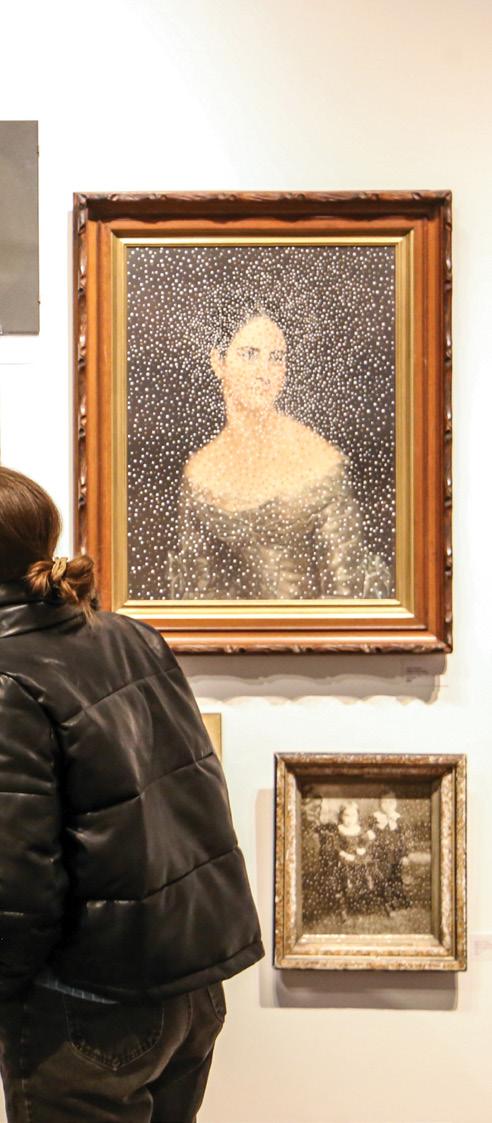


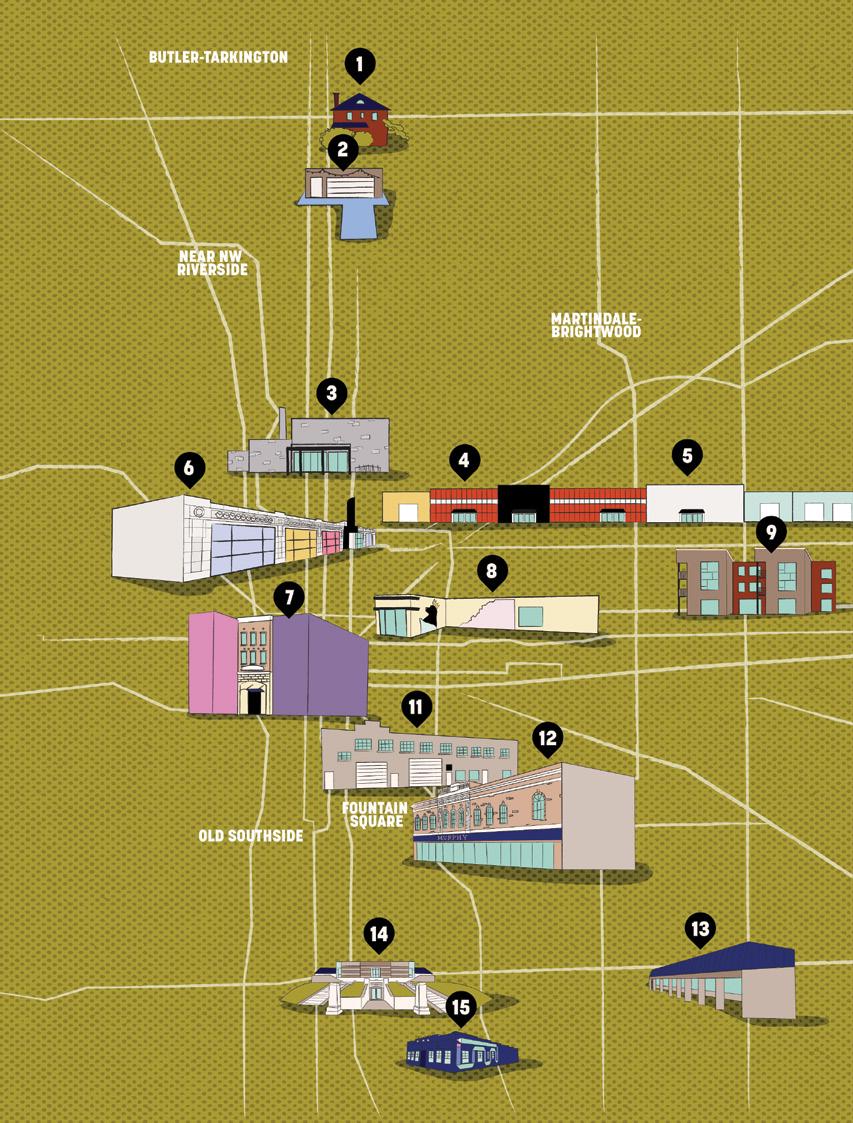
1. COMPANION 3715 N WASHINGTON BLVD.
2. STORAGE SPACE 121 E. 34TH ST.
3. HARRISON CENTER FOR THE ARTS 1505 N DELAWARE ST.
4. FULL CIRCLE NINE GALLERY 1125 E BROOKSIDE AVE. B21
5. CITY CIRCLE INDUSTRIAL COMPLEX 1125 E BROOKSIDE AVE.
6. GALLERY 924 924 N PENNSYLVANIA ST.
7. GALLERY FORTY-TWO 42 E WASHINGTON ST.
8. LOST DOG GALLERY 1040 E NEW YORK ST.
9. HOY POLLOY ART GALLERY 3125 E. 10TH ST. SUITE J + SUITE L
10. 1000 WORDS GALLERY 3328 E 10TH ST.
11. FOUNTAIN SQUARE CLAY CENTER 950 HOSBROOK ST.
12. MURPHY ARTS CENTER 1043 VIRGINIA AVE.
13. HEALER DIY 3631 E. RAYMOND ST.
14. GARFIELD PARK ARTS CENTER 2432 CONSERVATORY DR.
15. TUBE FACTORY/BIG CAR 1125 CRUFT ST.
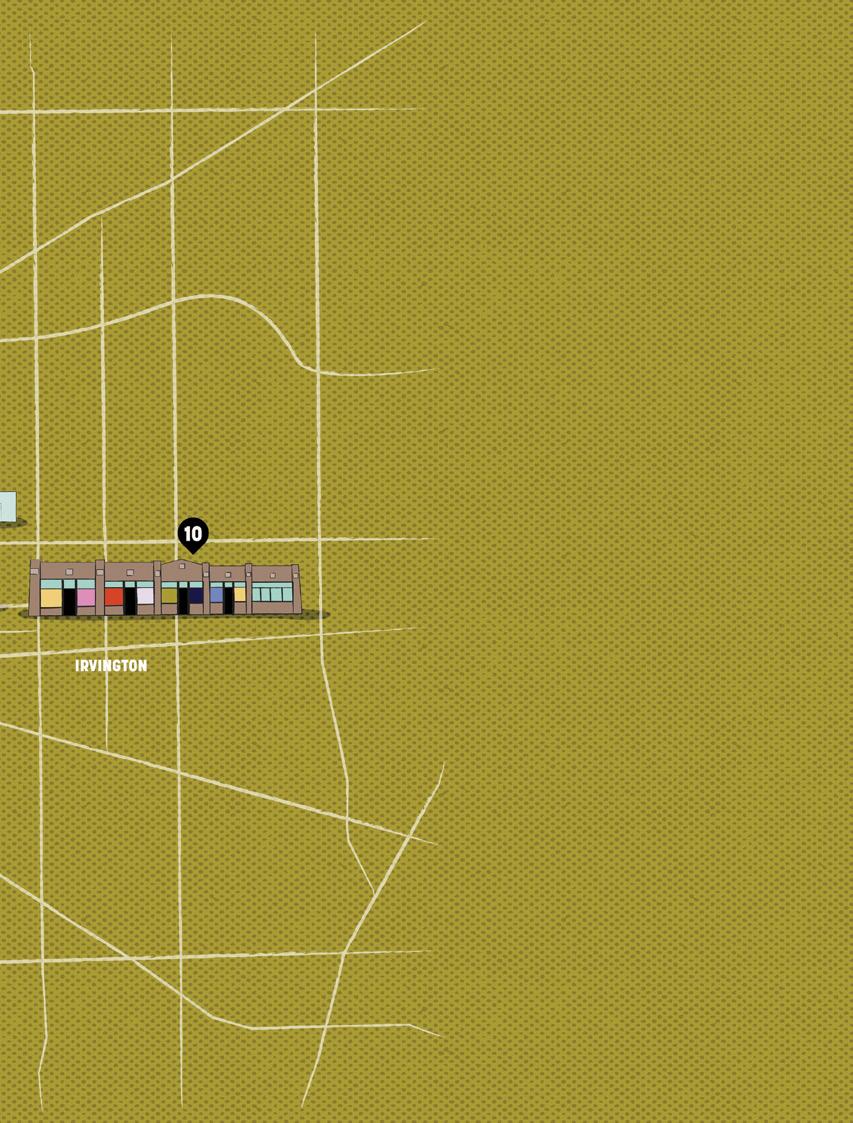
Outdoor opera, a Black fine art fair, suffragette theater, Jerry Garcia’s guitar, Brahms’ piano, ghostly art, a “Send Nudes” art exhibition—and much, much more. Discover fun & unexpected things to do this season by visiting our curated calendar of events at Explore.IndyArts.org.


IN BOTH METROPOLITAN AND RURAL AREAS, INDIANA IS HOME TO A PLETHORA OF FULL-TIME ARTISTS. Their studios are here, they exhibit their work here, and they understand the ins-and-outs of the industry. Indiana isn’t well-known for its quality art scene despite funding, galleries, and artist communities existing. Getting to know the artists that live and work here, one-by-one, is how we can start to change the community and funding for the better. Six artists living and working in Indiana reveal their insight about the creative economy, what it feels like to work in their studios, and what art means to them.
WORDS BY CORY CATHCART
Cyanotype is a photographic printing process that was first discovered by astronomer, scientist, and botanist John Herschel in 1842. A year later, Anna Atkins first used the cyanotype process for photography development. Though cyanotype is known for its signature Prussian blue, the chemical process can be manipulated with other elements to produce different colors. Casey Roberts is an Indianapolis-based artist working out of Circle City Industrial Complex who has been creating visual art with cyanotype for more than twenty years. Through his experimentation with the process over the years, he’s found different ways to manipulate the process to make different colors, like yellows and greens, and designs in his work. He makes simple images that feel comforting and clever
CORY CATHCART: Tell me about your process of creating.
CASEY ROBERTS: It's called cyanotype. It's one of the very first photographic color processes. The photographic process only prints out blue. In later years, it was used as blue line drawings for architecture. That's a more modern use for it. I paint with the chemicals like a watercolor. I expose it to light and when I wash it out it turns blue. I get a blue and white image, and then I can alter the image with baking soda. Several different things, like peroxide, have an effect. There's a lot of different ways to use it. I've been doing this for twenty plus years. Over those years, I’ve figured out different ways to manipulate the blue to get different effects. The plants, the animals–they all get painted on top. The work you’re seeing here is really simple technique-wise. It’s very fortunate for me that like when the blue is altered, the colors that it changes to are complimentary. There are things that fall in line to help me as an artist and make for a pretty image.
CC : Nature is very prominent in your work. How does nature inspire you?
CR: Nature is more pure and simple than we are. A lot of my work is just an attempt to be quiet. I don't get out nearly as much as I'd love to. It's a shame really, but I do love national parks and hiking. I did an artists program at UNLV. I was there for a week and fell in love with the desert. As an Indiana kid, I’d never really been out there. I loved it. The quiet is so eerie. That hasn't quite creeped to my work yet.
CC: Is there someone who inspired you to begin cyanotype?
CR: I went to Herron here in town. I was a printmaker. At Herron, you have access to all these printmaking tools. It was amazing. But once you graduate, you're kind of stuck. Right as I was graduating–I was dating at the time and am married to now–my wife, who is a photographer, and she introduced me to cyanotype. She's an amazing photographer and does her own great work, but I saw the chemicals as a process which appealed to my printmaking brain. From there, it kicked off exploring this technique, this process. You see a lot of great cyanotype work out there. Each artist is gonna bring something different to it. If you would have asked me at the time, I don't think I would have said I'd still be doing it. I thought it was just a brief thing, but it really has developed into its own thing.
CC: You have a lot of records in your studio. How does music inspire you and when did you start collecting?
CR: I started collecting in college in the mid-nineties. Back then records were cheap. No one really wanted records. It really worked out. Now everything's so expensive. At the time, you could buy collectible records really cheap. I’d spend my rent money on vinyl. Over the years sometimes you get poor and you have to sell some of your collection. [I’ve] been through that. Now I try not to buy as much, but I do love it. It's very inspiring. It kind of works out, you put on a record and you've got about twenty to twentyfive minutes to work, and then you have to flip it. That little break is great while you're working on a piece, so the timing works out really well.
CC: What do you think Indianapolis is doing well for artists and what do you think they could do better?
CR: I appreciate PATTERN for approaching this topic. It's something I think a lot about actually. Indianapolis is a great town. It's got its problems; every town does. But there are so many creative people here. There are so many great artists and musicians; music has really taken off. Indianapolis musicians are fantastic. Things that can be better… I think we need a gallery scene. I think the people who buy art are here. I know, because they come to my First Friday. I know that people are hungry for good art, and Indianapolis has great art. I think making the connection could be better. The buyers have to do more work to find an artist they like. First Friday is great. I spend most of my First Friday just talking about the work, the process, and making connections.
CC: Do you have a favorite piece that you've made?
CR: I have to say that the beaver piece I did cracks me up. I like things with a little sense of humor. I'm here in my studio all by myself. And if I can crack myself up while I'm working on a piece of art, I feel like I've won. A lot of these paintings start out with asking, “Can I make that with my process?” If I can figure something out, that's what keeps me motivated. Sometimes I geek out on technical stuff, sometimes I like funny conceptual things, and when they can both meet together it makes me laugh. ✂
“I KNOW THAT PEOPLE ARE HUNGRY FOR GOOD ART, AND INDIANAPOLIS HAS GREAT ART. ”
Beatriz Vasquez is an activist and visual artist inspired by papel picado, a Mexican folkloric art that focuses on the manipulation of cut paper. Raised in Southern Texas, they moved to Indianapolis to attain a degree from Herron School of Art and Design. Since graduating in 2006, Vasquez has been a full-time artist and active member of Indianapolis’ creative scene, and has had work featured in exhibitions across the globe. The artist’s work often finds its basis in their Mexican-American heritage and current pressing social issues that disproportionately affect vulnerable communities.
my family’s home, but we’re treated like we don’t belong here. My creative process was born from my diaspora.
EW: What project are you most proud of, and why?
to teach me, but he wouldn’t, because I was a girl. His work was impeccable. I wonder what he would think of me now that I’m an artist. I hope that he’s watching me.
EW: What does “creativity” mean to you?
EMILY WRAY: Tell me about your process of creating.
BEATRIZ VASQUEZ: The paper is traditionally cut with chisels, nails, and hammers, but I create with an Exacto knife, and I barely ever illustrate prior to cutting. I want to let my mind and my experiences and my culture guide me through my creative process. I start cutting and then layer and layer and layer, if that’s what I want to do. My work is starting to move into sculptural form, and a lot of it is suspended and organic, very much full of storytelling. My art has to connect with people. My art has to tell a story. My art has to bring awareness to social issues, the things I faced growing up, the things my parents faced growing up. We’re still dealing with racism, with the language of “You’re not from here. You don’t speak English.” Well, I am from here! But we’re all also from somewhere else. When I’m cutting the paper, I feel like I’m cutting the negatives from my own life and filling them with color. Every day when I’m creating I’m tapping into my healing process. I’ve always wanted to be an artist, and I’ve always wanted to create something significantly culturally-based here in Indy, because it’s
BV: There’s so many! I was invited to do an exhibition with the United States Art in Embassies program. I’m super proud of that, because my art was exhibited for three years in Sierra Leone. It was in the American embassy and in the American ambassador’s home. Now, a second residency has come my way through them, with an ambassador from Lesotho! For me, it’s always been about putting my mom and dad’s name on the map. Everything that I do is in honor of my parents, of my ancestors, of all those people who came before me and saw more injustices than I will ever know. I’ll tell you about another project that’s equally important. My mother was a domestic worker for many years. She would say that when she put her uniform on, it was like an invisible cape. In 2020, I was invited by the California Domestic Workers Coalition in San Francisco to create something to put on t-shirts for people to wear when Governor Newsom signed a bill to protect the health and dignity of domestic workers. I created myself (because I look just like my mom) with a COVID mask that was a monarch butterfly. The monarch butterfly is very significant in Latinx and migrant communities, because they can fly where they want to, but people can’t. I made this, and they went out and made hundreds of t-shirts! I felt so empowered, and I felt like my art empowered those women.
EW: Who is an artist that initially made you want to create?
BV: The very first person that taught me to love art was my sister, Hilda. She started working for a grocery store in South Texas as the store artist. I had never heard of that before in my life! She taught me that art is very important and got me my first job. When I turned fifteen, I became the store’s artist in another location. Also, my grandfather. He was a master carpenter, and he taught all the young men in our family to be masters. I always begged him
BV: Creativity means healing. If you love it and it’s helping you heal from whatever trauma, even the smallest thing, that’s creativity. Growing up, my parents couldn’t ever afford a Barbie doll, but I learned to create them. I learned how to hand sew, to draw their faces and make them brown with black hair. Creativity brings me a lot of satisfaction, but I don’t care about how the work looks sometimes. I care more about the process. What incited my creativity? Was it a bad memory that I turned beautiful? Was it a good memory I turned into something more beautiful? Creation is embedded in all of our humanity. Every time I teach kids, I say, “Hello, fellow artists.” And they go, “Artists?” And I go, “Yes, you are!” We’re all artists, because we have something important to say. It’s a connection to culture, to memory, to ancestral homes and beliefs and the things we’re starting to lose.
EW: How does creativity and art impact the development of Indiana?
BV: I felt lonely in the art world here in Indianapolis for a long time. Only recently have people here in Indianapolis really started to connect with me. I feel that Indiana needs more culturally-based artists, because that enriches culture and diversity. It promotes beneficial humanity among everyone. I’m elevating my culture and saying this is what I have to offer. Indiana benefits from artists like me, artists of color that will tell their stories from wherever they are. There’s so much richness for these rural and urban communities. Indiana has come a long way, but coming from someone who has traveled around the world, it has a long way to go. We need to bring these communities into the art world and invite them diligently and purposefully. ✂

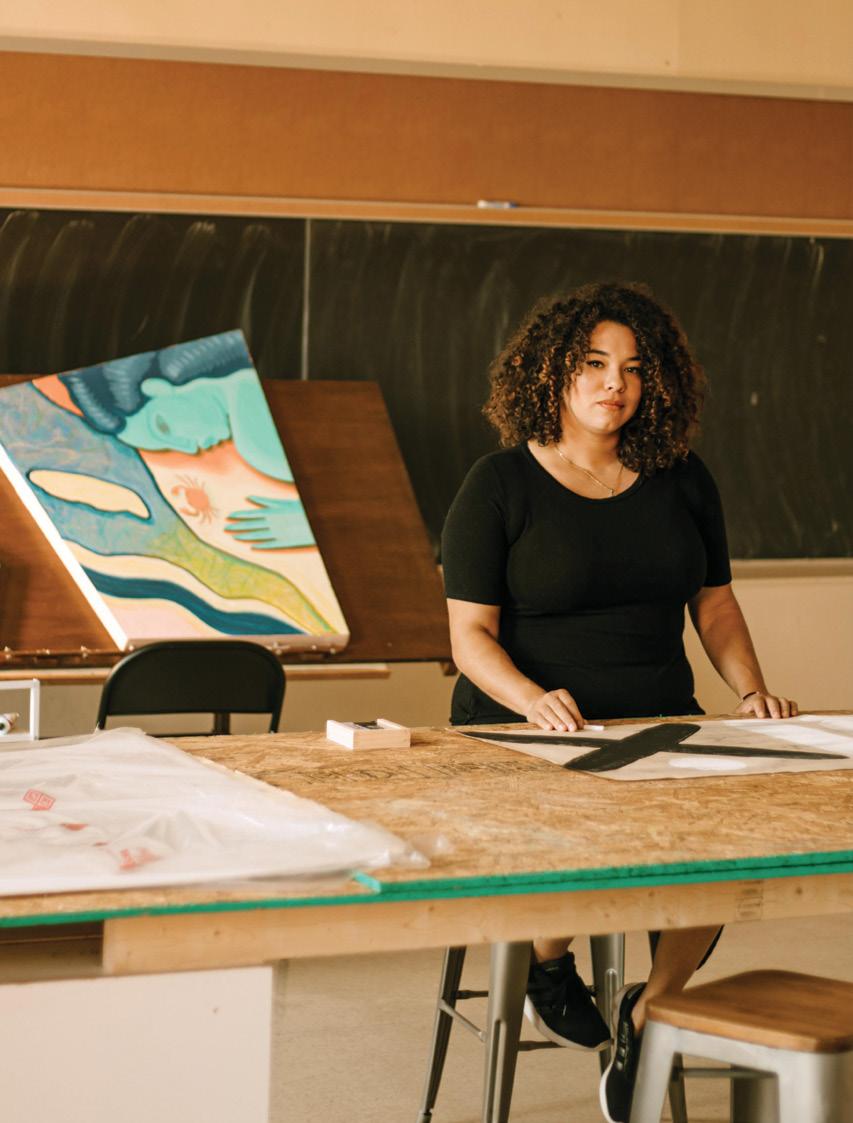
Lyndy Bazile is a local artist that’s all about inclusion. The feminine vibrancy that exudes through her numerous paintings puts emphasis on the strength and diversity of all women. Bazile’s art has been featured at festivals and art fairs in several states within the Midwest. Although her hometown is Fort Wayne, Indiana, her desire to connect with her Haitian ancestry is another big inspiration behind her artwork. From computer animation to largescale paintings, Bazile uses her craft to support and inspire marginalized groups and celebrate diversity.
DESTANY LONG: Tell me a bit about your background. When did you get into art and how did it lead you to where you are today?
LYNDY BAZILE: From a very young age, I enjoyed making art. In my early twenties, I taught myself how to animate with a tablet and I got a job in Massachusetts animating a web series with some comedians for a few years. That experience was a pivotal moment where I realized that I could do art as a career. After that job ended, I went to school and got my degree in animation and computer art. After I graduated in 2018, I started painting instead and never opened my computer. I started experimenting with paint and developing a studio practice. I've never taken a studio painting class, but I am a painter now.
DL: What project are you most proud of and why?
LB: I do lots of large-scale murals and smaller paintings. This piece that I did most recently for BUTTER is a mixture of the two. It's a very large scale; it's eight feet by eight feet, but it can also be broken down into smaller pieces and separated. This most recent piece is my proudest piece because it took a lot of deep diving into the history of Haiti, which is where my dad is from. A lot of my work circles around trying to connect with my Haitian ancestry and explore those roots. This piece was next level for me. I learned so much while doing it and so much came out of me intuitively that I didn't even know about Haiti. The whole concept of it being a larger piece but also able to exist in smaller fragments and being intended to do that felt like a big accomplishment for me.
DL: What does creativity mean to you?
LB: Creativity to me means making the conscious effort to try and think of new ways to be better, to make things better, or to envision a better future. It’s making a conscious effort to think about
those things in different ways and being able to manifest something that will help that vision come to fruition. Creativity for me has to be a positive thing—something that moves humanity forward in the right direction. If it's something that's bringing harm, I don't think that's creating. It’s destructive.
DL: What organizations or people have helped you financially as an artist?
LB: The first organization that made a huge difference for me was the Friends and Family Fund in Fort Wayne. I needed help, and they came at the perfect time. They were giving grants to creatives and entrepreneurs in the southeast side of Fort Wayne that the Board thought could use it. It was out of the blue for me. They found me and they wanted to support me. The grant was substantial and it really made a difference. I don’t think I could've continued in art at that time if I hadn't had that support. That was about two years ago.
Another one is the Community Foundation in Fort Wayne. They have supported me recently with a grant to help engage with my community and build out my studio. They are helping me to support the community through my art, which is what I really want to do. Not to mention GANGGANG making such a huge impact as far as creating value in the market and creating action and excitement around this thing that we all want to share in this culture. That's extremely valuable.
DL: How does creativity and art impact the development of Indiana?
LB: I hope that art can pave a way for people to get more politically involved in Indiana. Residents who have been pushed to the margins in many ways can be united by public art and work towards establishing a shared vision of what the future could look like for Hoosiers. ✂
"WITH MY ART, I HOPE TO CHANNEL NEW PERSPECTIVES, SUPPORT PEOPLE WITH SHARED IDENTITIES, AND EXPAND EMPATHY AMONGST OTHERS.”
Jay Parnell has been an accomplished member of Indiana’s creative community in different facets for decades. The selftaught narrative painter’s distinctive work in portraiture incorporates Christian iconography and historical elements with incredible precision, and has been showcased in collections across the United States, Europe, and the Caribbean. Though painting is his calling, Parnell’s family is his top priority, and he maintains a part-time position to support them in addition to his artistic pursuits. His experiences are a testament to both the need for and the unsteady nature of the Hoosier State’s creative economy, and the contemplative nature of his work is both haunting and captivating.
EMILY WRAY: Tell me a bit about your background.
JAY PARNELL: Well, long story short, I’ve always been an artist. My father was a visual artist, my mother was a poet, and my brother is a muralist. I’ve been painting and drawing my whole life. After I graduated from college, I had my first professional artistic job at Ball Corporation in Muncie, where I worked as a photographer and, later, an illustrator.
EW: What project are you most proud of, and why?
JP: I really enjoyed the last show I did at the Harrison Center, This Valley of Tears. It was a show of some of my best work, and I pulled it together over the course of six months.
EW: Tell me about your process of creating.
JP: I always try to be brainstorming. The process of creation is a perpetual thing. I’m always thinking about titles, reading essays and poems and listening to music, and looking for things that can help me in my journey. I may be inspired by a painting from another contemporary artist, or maybe even an abstract artwork or a fashion spread. Any number of things can spur my creativity. I’m a big concept person, and I always have an idea that I’m thinking about. I take my thoughts and put them down on paper, and then I start doing sketches, and then I allow myself to develop the sketches into drawings or a full composition to be transferred to a painting panel to begin my painting.
EW: How can Indianapolis become a place that is better suited for artists to live in?
JP: Indiana hasn’t been that good at developing the creative class. Unfortunately, that’s why most people in the creative class leave Indiana—I stayed because my primary goal in life is to build a loving family, and creating my work comes after that. I think we seriously lack a dedicated financial base. We do have a financial base—let me be clear on that—but it’s not large enough to sustain very many careers for artists in Indiana. I’m a tribute to this. I have a part time job, but I really love to paint, and I do a good job at it. If there was a larger base of
local collectors and sponsorships, that would help creators stay in Indiana. Not just foundations, but individual people coming in and saying, “Hey, I like what you’re doing, I want to support you on your project.”
EW: How does creativity and art impact the development of Indiana?
JP: We need to be talking to young people and helping them understand the value of art, because it’s a lifelong pursuit. It’s a lifestyle, and it’s foundational. All kids are artists when they start out, but they’re not taught to appreciate the creative process. By the time they’re adults, it’s about making money and doing other things. But creativity is important, because it’s about life. Artists say, “This is where we’ve been, this is what we do, this is who we are, and that’s why it’s important.” The artists, the writers, the dancers, the performers, the musicians—we are your signposts. When history looks back, they’ll be able to hear the music and see the artwork. Creating beauty is important because it is our conversation with the divine. And artists are the most responsible for creating beauty in this world. If we’re not creating beauty, what are we doing? That’s why it’s important to have our focus on the long game and not short, disposable solutions. ✂
"WE NEED TO BE TALKING TO YOUNG PEOPLE AND HELPING THEM UNDERSTAND THE VALUE OF ART, BECAUSE IT’S A LIFELONG PURSUIT. IT’S A LIFESTYLE, AND IT’S FOUNDATIONAL."

 INTERVIEW BY KATIE FREEMAN
PORTRAIT BY LEO SOYFER
INTERVIEW BY KATIE FREEMAN
PORTRAIT BY LEO SOYFER
Indianapolis-based artist Tom Day has been creating art since he could hold a pencil, but what started out as a fascination for classroom cartoon doodles has evolved into a portfolio full of portraiture. His paintings and digital artworks spark conversations surrounding social justice, which he navigates through the lens of his own privileged perspective. Day feels as though he’s got a responsibility to use his spotlight to speak on things he sees as harmful, whether it’s politics, racism, or toxic Christianity. His most recent solo exhibition, “Condition,” largely centered around these themes and invited the viewer to question existing social structures and issues such as hostile architecture and price gouging.
These ideas of heavy artistic investment from larger corporations and other large grants give a sense of accessibility to consumers, artists, and creatives that are really important.
KF: Where is your studio and how would you describe its design?
TD: It's a studio apartment at the Harrison Center. It looks like a studio or a gallery space. I've got gallery lights in there and a big white brick wall. It's always been a balance to figure out how I can make it look approachable and accessible to the average art admirer while still finding a way to use it as my living space. I don't want anyone coming into my space to ever feel like they're intruding. Finding a way to disguise it as just a studio space is important to me, and over the course of the four years I've been at the Harrison, I've done a really good job.
KF: How does that impact your work-life balance between living and creating?
creating more spaces for artists is really important.
KF: Tell me about your process of creating. What does creativity mean to you?
TD: I grew up learning traditional mark-making, proportion, shading, and line. My parents signed me up for art lessons when I was in kindergarten with a local artist named Carol Conrad. That baseline propelled me forward and allowed me to explore that creative side and make work that is conceptually imaginative and visually representational. I wasn't constrained with trying to make sure everything was just right. Everything has come really naturally to me, and because of that groundwork, I work really quickly. I work very representationally and I owe a lot of that to who she was to me and a lot of other kids at the time.
KATIE FREEMAN: What project are you most proud of and why?
TOM DAY: As an individual piece, “Previously Known” was a groundbreaking work for me. It wasn't as representational as some of my other pieces. It was silhouetted, it wasn't a person, and that pushed my boundaries artistically and conceptually.
Collectively as a project, my solo exhibit “Condition” is something I'm really proud of. I put together work that again pushed those boundaries for me artistically and conceptually but also invited other people into what's going on in my brain and what I'm passionate about. I hung the show, looked around, and thought “I haven't had that gratification or sense of pride in my work in quite a long time.”
KF: How can Indianapolis become a place that is better suited for artists to live in?
TD: The biggest thing right now is accessibility. We're on our way with the second annual BUTTER Art Fair and what that has spurred in the Stutz Building: a sense of investment and revitalization of something that was once amazing and is on track to be that again.
TD: It's tough. That's why I have such a hyperfixation on working outside of my space. I'll go to different coffee shops or spaces where I feel comfortable to be away from where I sleep in order to create this newer environment and sense of inspiration. I do a lot of finishing touches or any larger-format hardware projects in my studio space. But ultimately, I like to go out and work using digital mediums, like working on my iPad. It has a special place in my heart because I'm not confined to just working with traditional media at that point. I can do just about anything—not that you can't use traditional media outside of your studio space—but this allows me to take my art wherever I go. I'm super grateful for that.
KF: What do you think our current art gallery situation is like? Do we need more visibility for them or more galleries in general?
TD: I would always advocate for more gallery spaces. I think those innately attract more people and allow space for community. There are a lot of bigger “powerhouses” in the artistic community in Indianapolis but there are smaller galleries popping up that have done an incredible job. Justin Vining opened up his own gallery space, Vining Gallery on 10th Street, and it is incredible. There's a sense of modernity that comes from that sort of space. People are oftentimes seeking a space that's new. We're always looking for something fresh. I don’t think it’s one or the other. Having more visibility for artists and
Creativity is allowing yourself and your authenticity to enter spaces not previously imagined by the outside world or by others. While it can be inventive, it’s also heavily rooted in the creator itself. That's what's so beautiful about art, being able to use your talent and passion to say something you're thinking that others might not be thinking, or use your voice to have others create these ideas in their head.
KF: How does creativity and art impact the development of Indiana?
TD: There's a lot of money that comes from art. We just saw that with BUTTER 2. We're seeing communities that have been brushed to the side for so long coming into the spotlight. As a pretty progressive city, a lot of people are loving that and wanting to participate in that revitalization. This access to Black art and culture has created a whole new spotlight on what we can do in the city to make everything more equitable. That's what the power of art can do.
I'm learning about all these communities that have been completely destroyed in our time. I learned about IUPUI and how it completely obliterated Black communities through its construction and its implementation. It is important to not only recognize and be mindful of that, but take action to see a more beautiful future. BUTTER is the best example of that right now in Indianapolis. It's one of the coolest artistic fairs that I've ever experienced, especially in the Midwest. Having that collective passion and community is something that I want to see across the board in Indianapolis. ✂
On the third floor of the labyrinthine Stutz Building, Taylor Smith is re-interpreting the pop art she grew up with in the seventies. Her work incorporates unique mediums like silk screen frames and spray-painted floppy discs to create funky, colorful visual art pieces. Mickey Mouse, Marilyn Monroe, and Abraham Lincoln are just a few examples of the famous figures featured in Smith’s artwork, which combines oil paints and screen printing to focus on themes of nostalgia and consumerism. Society’s fascination with fame, wealth, and tragedy is communicated through Smith’s works, which have been featured across North America, in Europe, and in high-profile collections.
KATIE FREEMAN: You’ve had a studio in the Stutz Building for fifteen years. How would you describe your space?
TAYLOR SMITH: When we used to have open-house studios, everybody would come in here and say “This is the most comfortable, coolest studio.” I have some carpets here and there, I painted my walls black, I always have music going, and the lighting is right. When I moved in here, this was just a white box. The floor was white and I painted it to look like an old factory floor, like the rest of the building. I painted all the columns and I scraped all the paint off the brick walls to make it look aged. I put two weeks of work into this before I moved in. It's extremely personal to me. I want the right vibe if I'm going to be in a space that makes me feel creative.
KF: Who is an artist that initially made you want to create?
TS: I would say Warhol was probably one of my biggest influences. This summer I was asked by the Cleve Carney Museum of Art up in Chicago to be in a show and lend a couple of my works that were influenced by Warhol. They hung them directly next to the original Andy Warhols in their collection. They had a dialogue between Warhol’s paintings and mine, and they’re acquiring one of my pieces for their permanent collection now. That was a big honor for me, having my work intentionally compared to his.
KF: Tell me about your process of creating. What does creativity mean to you?
TS: A lot of my ideas are from things I see every day in media and things in the back of my mind from my education studying art history. Whether it's Renaissance painters or pop artists or abstract expressionists, I try to blend a lot of what I've learned into my work because it's familiar. It's good for a reason, and I use that as a stepladder to stand on and keep going. I will originally come up with an idea I want to incorporate, sketch things out, and then translate that into a final work. I use a combination of screen printing, drawing with pencil, and painting for that.
To me, creativity means the freedom to be able to interpret what you see and express yourself. I love working for myself. Every day I can wake up and decide “I want to do this,” and hope that it works— but you don't know. That's part of the creative process. It's experimentation. When it pays off, it's very rewarding.
KF: Are there any organizations or people that have helped you financially as an artist?
TS: The Arts Council and the Lilly Endowment. I've had a few really nice fellowships and grants there and that's been very helpful. The Lilly Endowment and Eli Lilly have purchased and collected my work.
KF: How does creativity and art impact the development of Indiana?
TS: The more a city has a really strong creative foundation, whether it's visual arts or music or performance arts, corporations are attracted to that as quality of life. Honestly, the quality of life has gone down a bit with the local government cutting funding for the arts. That really hurts. It affects companies like Salesforce and Lilly, and they don't want to have people in a city that doesn't have a flourishing creative scene.
KF: How can Indianapolis become better suited for artists to live in?
TS: With the Stutz Building being under construction, a lot of artists have had to move out. I've been looking around to see what is available in the city, and this city needs more affordable and beautiful studio space, not like an office with popcorn ceiling. I'm talking about really cool buildings that are—instead of being turned into offices—more like a creative loft-type space. But in general, the art scene is great. There's hardly any galleries anymore. That's kind of depressing, but I don't know that the business model really works. That's why they're not here.✂
"TO ME, CREATIVITY MEANS THE FREEDOM TO BE ABLE TO INTERPRET WHAT YOU SEE AND EXPRESS YOURSELF. I LOVE WORKING FOR MYSELF."

WHETHER OR NOT WE ARE AWARE, ART IS PRESENT in nearly every choice we make. Design, color, and composition influence our daily experiences. A few years ago, I learned the importance of judging an album by its cover. The artwork of an album influences who buys it and why. The first thing you notice about a record is what it looks like–some catch your eye, some don’t.
The same could be said for a cocktail. The food and drink industry is a place where art is present and is a determiner of how successful the business is. Indianapolis is home to chefs, and bartenders, who make our dining experiences photo-worthy. We asked five local bartenders to combine the artistic appeal of fancy cocktails with the nuanced influence of album artwork, and the era-defining music inside.
WORDS BY CORY CATHCART PHOTOGRAPHY BY BROOKE TAYLOR RECORDS SELECTED& PROVIDED BY SQUARE
CAT VINYL
 BY ELTON JOHN
+
BY ELTON JOHN
+
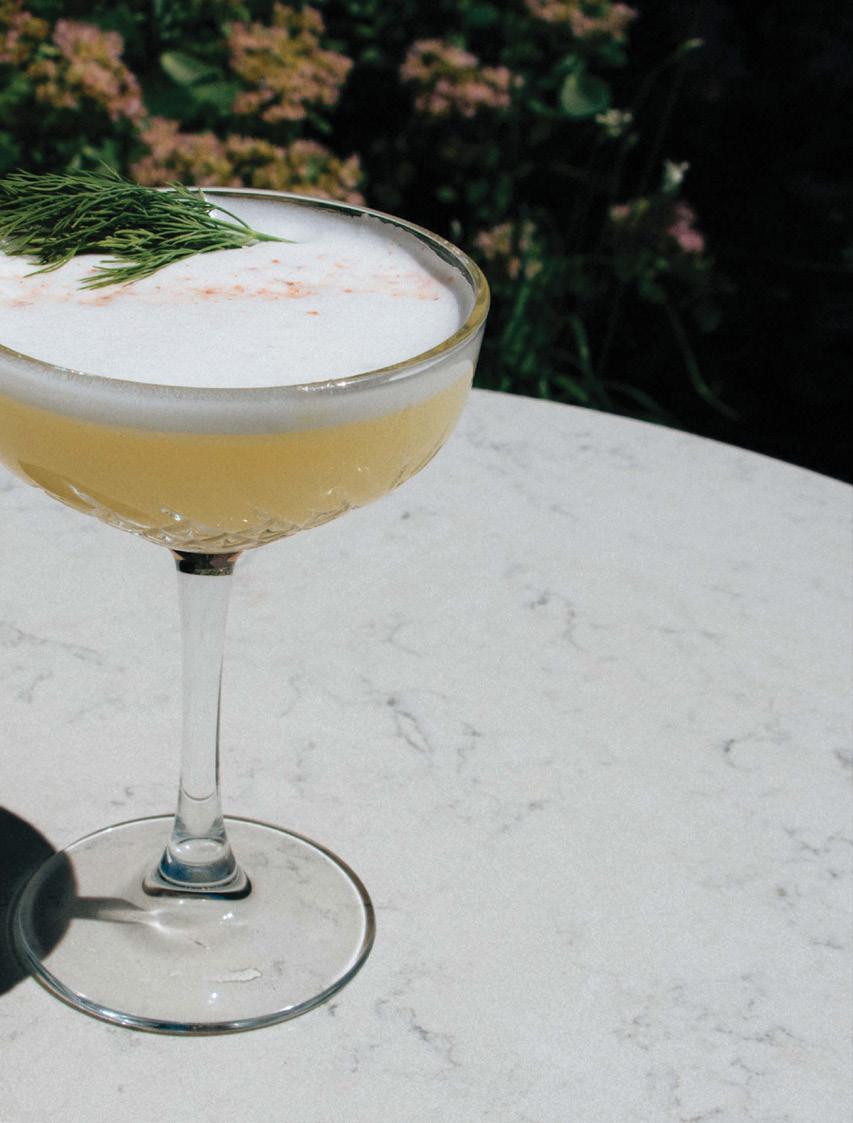
1.5oz Hi & Mighty Big Fuss gin
.75oz Giffard pamplemousse liqueur
.75oz champagne/corn cob simple syrup
1 egg white
.5oz lemon juice
Pink Himalayan sea salt and dill garnish
“My tribute to Goodbye Yellow Brick Road is a riff on a gin fizz. I chose the ingredients based on the palette of the album art. The champagne and corn cob simple syrup really sums up the theme of the album. Sir Elton sings how he’s tired of the big lights, glitz, fame, and fortune associated with his celebrity life, and how he’d likely be more fulfilled by a modest, peaceful life back on the family farm.”
-JAKE JOHNSON

2oz Hotel Tango ‘Shmallow toasted marshmallow bourbon
1oz fresh pineapple juice
.75oz fresh lime juice
.5oz chipotle-cinnamon syrup
Rainbow ice cubes
Dragon fruit aquafaba foam
“The bright colors in this cocktail are heavily inspired by the album artwork. I really enjoyed the funky jazz fusion journey the music took me on, so I wanted to create a flavor to match the energy: a little spicy, a little smokey, a little sweet. The colors combined with the exciting palate led me to name this cocktail Funky Fusion.”
-HOLLEH MATLOCK
 BY PRINCE AND THE REVOLUTION
BY PRINCE AND THE REVOLUTION
1.5oz St. George raspberry brandy
.5oz dry orange curaçao
.25oz lemon juice

Topped with prosecco and dry shaken beet aquafaba

“I decided to go with a lighter spritz riff. The incorporation of the beet aquafaba creates a Purple Rain situation as it cascades through the ice. I found this quote that brought me to the purple froth garnish that really brings home the cocktail for me. Prince explained the meaning of Purple Rain as follows, ‘Purple rain pertains to the end of the world, and being with the one you love and letting your faith or god guide you through the purple rain.’”
-MARCUS SWAFFORD +1.5oz mezcal
.75oz lemon
.5oz strawberry-infused Montenegro
.50z agave
.25oz strawberry sage balsamic shrub
4 dashes of chocolate bitters
3 dashes of saline
1 egg white
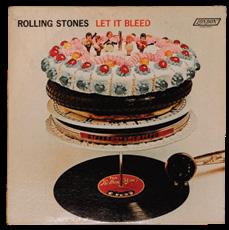
 BY THE ROLLING STONES
+
BY THE ROLLING STONES
+
“My cocktail was inspired by the album cover. I took reference from the cake. I wanted to make something fruity and incorporate egg white as a nod to the icing on the cake. I used a levitation device to display the cocktail in reference to the cake stand. The Rolling Stones were known for their tequila sunrises, so that helped me pick out my spirit. Mezcal has gained popularity in recent years, and I really enjoy the smoked quality from it.”

 BY COREY EWING FOR STRANGEBIRD @STRANGEBIRDINDY
BY COREY EWING FOR STRANGEBIRD @STRANGEBIRDINDY
3 drops of 20% saline solution
3 dashes Black Walnut Bitters
1oz Averna
2oz Appleton 12 year
“I put a twist on this cocktail for Billie Holiday’s album, Stay With Me, not only for its name, but for its vibe of comfort and joy. The album was recorded in the early years of the Civil Rights Movement and released only the year before The Federal Bureau of Narcotics targeted her, hastening her death in New York City. It was her calm before the storm. As a final nod, Appleton Rum is blended by Joy Spence, the first woman to become a Master Blender in the spirits industry.”
-COREY EWING



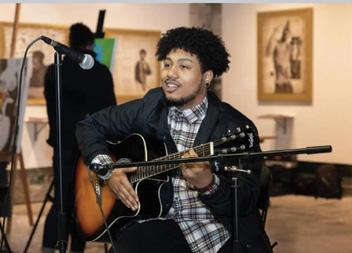




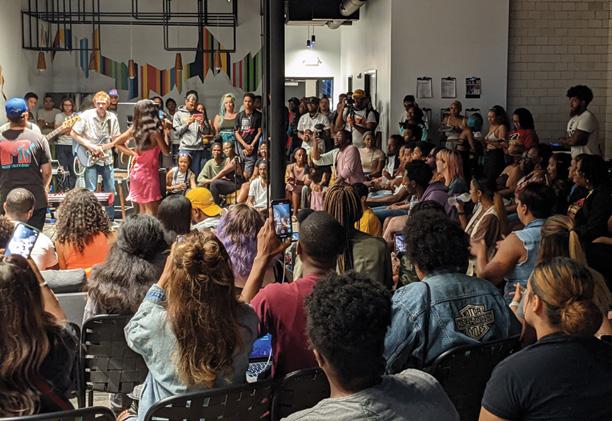
KEEP GOING EAST ON 10TH STREET. Past Bottleworks District with its lusciously-restored white tile and gold lettering naming each of the tenants in the $300 million development. Keep going east, past the spot where the Monon Trail and the Indianapolis Cultural trail connect, underneath the torn-up interstate bridges, past the Circle City Industrial Complex where many artists and entrepreneurs are incubating inside that cavernous space.
Keep going. That is not the end of the interesting parts of Downtown Indianapolis.
Arrive at the corner of 10th and Jefferson, which is probably the start of 10 East Arts. But there’s no need to get so specific here—you can say it starts where you want it to.
10 East is just as much a place as it is an attitude, a state of mind, maybe even a vibe. It’s for you to visit, or not. It’s an area made for and by its residents. You are welcome here, but you’re not likely to see a citywide marketing campaign for this district that bridges Downtown to the east side of the city.
This is a place where residents and entrepreneurs are placing multi-hundred and multi-thousand dollar bets. A place where the arts and cultural experiences are authentic centerpieces of a community redevelopment strategy. This is a place where you can see people personally investing in their futures.



Such as The Mad Griddle at 2127 East 10th Street, a restaurant that Amanda and Tim Jones opened in September 2021 with about $100,000 from their own savings. They remodeled an old nightclub into a place that has its own style, a “mad” one, and they each work in the restaurant—Tim in the kitchen and Amanda out on the floor, offering up Sunday morning live jazz brunches, pizzas with names like “Overweight Lover,” and Mad Wine Slushies.


Next door, there’s Rabble Coffee Shop with its dark brews and vegan pastries. (The side of their building once bore a mural by the famous Louisiana-based artist Muck Rock, but the community quickly tired of it and painted over it with a kind of gallery of murals, each made by residents). Go into the bodega Dear Mom and check out the small-run art publications, the kombucha in the cooler, the mix tapes, local produce, clothes, and whatever surprises are on hand that day.
Keep going. It’s all here: Burger King, Clark Gas Station, apartments, boarded-up storefronts, motorcycle parts, an old gas station transformed into something called Re:Public. Yes! The pop-up art space at 2301 E. 10th Street is managed by the John Boner Neighborhood Centers. It’s a venue you can rent for a half day, full day, or up to five days, at cheap AirBnB rates ($75 - $150 a day). The only requirement is that you have to do something “creative” there. According to Joanna Nixon, an independent arts administrator and leading 10 East dreamer, the venue has been rented more than 75 times for arts and culture events already in 2022.
Churches, appliance stores, houses and for sale signs foreshadowing change, residents greeting you from their porches, Wednesday night Karaoke at the Tick Tock Tavern, Vining Gallery (home to Justin Vining’s signature landscapes and paintings), a watch repair shop, and what was for a short while the home of the Israelite School of Universal Practical Knowledge.
Look it all up. And keep looking, because this area is ever-changing.

There’s a new taproom, the 18th Street Brewery, near the corner of Rural and 10th. What Indy hipster is coming out to 10 East Arts to drink beer here? The owner of the brewery, Drew Fox, is betting on building a new community here around beer and food. If Upland has created a community of dads riding bikes and drinking beers at 49th and College, then of course there’s a community of beer enthusiasts at this corner. It’s just different.
More gas stations, boarded-up buildings, liquor stores, the old Rivoli Theater, more churches, Tim and Julie’s Another Fine Mess (an architectural salvage joint) and the Teeny Statue of Liberty Museum, another Muck Rock mural, barber shop, the well-hidden Cat Head Press. Look it all up and check it out.
Now arrive at the 10 East Arts Hub … a new place, a centerpiece, a community arts space. The Boner Center owns and renovated the building, which was a 1920s ice cream shop and in the early 2000s, a coin laundromat. The aforementioned Nixon oversaw its renovation which was supported by a special grant from Lilly Endowment Inc. This grant allows, among other things, the Boner to program the space and occasionally rent it out for a fee. It’s used all the time: by emerging musicians playing jazz, hip hop, R & B. Or young artists experimenting with different ideas from fashion to painting, or whatever gallery show someone can dream up and trot out. Advocacy, community discussions, the film “Iron Giant” playing in the little park next door. Kids dancing.
The 10 East experiment begs questions and dangles answers. What does it look like to have a community that has places for young creatives to show and sell their work? What does it look like for a community to create its own type of events? What does it look like to have art for and by a community that calls this place home?
"THE 10 EAST EXPERIMENT BEGS QUESTIONS AND DANGLES ANSWERS. WHAT DOES IT LOOK LIKE TO HAVE A COMMUNITY THAT HAS PLACES FOR YOUNG CREATIVES TO SHOW AND SELL THEIR WORK?"


ARTS + CULTURE
10 East Arts HUB
1000 Words Gallery
Beyond Barcodes Bookstore
Cat Head Press
Guide and Anchor
Hoy Polloy Gallery

Re:Public Pop-up artspace


Streetly
Vining Gallery
INDEPENDENT RESTAURANTS
10th Street Dinner
18th Street Brewery
Beholder
Chucks Coney Island
Gomez BBQ
MayFair Taproom
Rabble Coffee
Sidedoor Bagel
The Mad Griddle
Tick Tock Lounge
RETAIL
Audrey’s Place Thrift Store
Dear Mom
Tim and Julie’s Another Fine Mess
Come look. I’m sure you can find someone who could put a dollars-and-cents return-on-investment number to this, to tell the Indianapolis Chamber of Commerce-ish story of economic development impacts. But. With only that, you may not see what value is being created here. You may not see that this is just getting started. This is all just a shot, a trial, a chance to see something become itself.
Keep going east. Get lost in Audrey’s Place and find the lamp you probably don’t need, but should buy. Have a vegan reuben and a cold beer at the 10th Street Diner. Stop in to Guide and Anchor to get your new venture branded, check out 1000 Words Gallery, or look next door into Streetly and grab some of Gordo’s fresh streetwear at his first brick-and-mortar store. Stop at Beyond Barcodes Bookstore, and read everything on Barack Obama’s Summer Reading List, even this winter.
All of these words: it’s interesting. Don’t mess this up, keep going. ✂
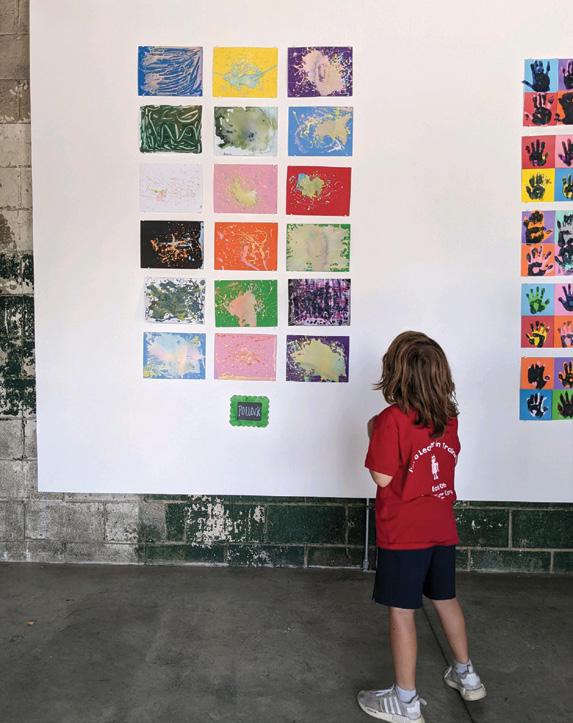
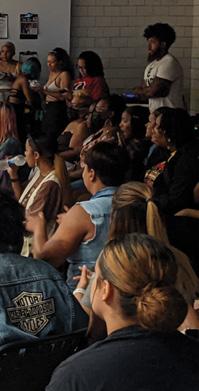


Julian Jamal Jones is an interdisciplinary artist born and raised in Indianapolis. After specializing in fashion photography for nearly five years, Jones switched gears while receiving his MFA at Cranbrook Academy of Art. Though his MFA was in photography, Jones gravitated towards fabric and textile art and began creating quilts based on corresponding oil pastel sketches. Together his drawings, textiles, and sculptures are used to contextualize Jones’ Black identity and memorialize Black culture. Whether he’s coding language through the use of abstraction or opening up a conversation on his Black experience via sketches, art serves as his most direct form of communication. This past September, Jones took his talents to Detroit to display his solo exhibition, “MARKINGS.” Before heading up to the show, he sat down with PATTERN to talk all things art.
KATIE FREEMAN: You’ve shifted focus from fashion photography to create textile art. Tell me about this new medium.
JULIAN JAMAL JONES: With my fashion background, I still have inspiration from fashion and construction. It’s more about my Black identity in America and where I belong. It also connects to my family history as well. My grandmother quilted and my great-grandmother quilted. It’s like a clash of all our inspirations and family roots. It’s rewriting what a quilt can be. It can be functional, it can be nonfunctional, it could be a fine art piece, it could be something that you cuddle with in bed. I’m trying to break that boundary.
KF: Your work incorporates both oil pastels and textiles as mediums. What originally drew you to those art forms?


JJJ: I’ve always liked art. I think I was born to be an artist. Working in abstraction is one thing that I really capitalize on. It’s not literal; it’s open to interpretation. I’m not forcing a narrative. So it’s like I’m drawing in code and symbols, coding language. I might know what the work is about, but the audience might not know. It’s for me to be open-ended and do what I want to do without being judged. I make sketches, and then turn them into textiles. It’s a two-step process for me. What attracts me to drawing is the beauty behind it.
KF: Your solo exhibition “MARKINGS” uses both those art forms. How do they come together to express your experience as a Black artist?
JJJ: A lot of my work starts off with music as inspiration: hip hop culture, jazz, even gospel. I listen to all forms of music. My dad was a big jazz person, so I remember listening to jazz music in the car. He was a DJ as well, so I was always surrounded by different forms of music as a child. That body of work is like a continuation of what I’m doing.
The work is darker, it’s heavier, but in a way, it’s more open to who I am as a person now versus my previous work. This work was more heavily influenced by music. You can tell by looking at the textiles. They’re more freehanded. The quilts have a black base, so it’s a black background with vivid colors on it. That’s the first time I’ve ever explored the color black within my work. Black can open so many doors into what black means. You can take black as a new discovery, depression, darkness or an exploration.
KF: As a recent graduate from Cranbrook Academy of Art, how has receiving an MFA in photography impacted the way you create art?
JJJ: I’m more critical. I feel more comfortable opening up now. I feel more confident as an artist. The MFA has really helped me to explain my work and think through my process. I can ask myself, “Does this make sense? Does this not make sense?” Having an MFA has opened many doors. I’ve met a lot of curators and collectors, which is huge. You want people to buy your work!
KF: Craft, composition, color theory, textile design— these elements all play into your artistic process. Are any of those most important to you, and why?


JJJ: Composition is big for anything. It’s big for photographers, painters, textile artists, etc. It’s important to me because if you don’t have good composition, then the work is not good. Color plays a big role, too.
KF: What’s your process for approaching composition?
JJJ: It’s a therapeutic process. I meditate a lot. Whatever speaks to me or makes sense to me—I just go for it. I don’t question anything. I just let it talk to me. The fabrics talk, the colors talk, the textiles talk to me. I think I have a natural eye for what looks good and what doesn’t, so I just go with what my gut tells me.
KF: It sounds like a lot of your work comes from artistic intuition. What does that intuition feel like and how does it bring ideas to life?
JJJ: With my current educational background, I can sense what people like and don’t like, in a way. Looking at other successful artists—and this is where it gets tricky—you don’t want to compare yourself to them or defeat yourself because you’re not where
they are. But I look and study historic painters and photographers, what they’ve done, and what people have accepted them into. The intuition comes more from my experience and my education. I know what is not hot and what is.
KF: Your work was featured in BUTTER 2. What was it like to have pieces on display in a space specifically meant to highlight Black art?
JJJ: It was a great experience. I’m from Indianapolis, but I’ve never had work exhibited or on display here. People know me as a fashion photographer, so it was my first time introducing myself as a textile artist here. I had two pieces purchased. I don’t know who bought the second piece, but the first piece was bought by the Richmond Art Museum in Richmond, Indiana. I’m really excited. It is in their permanent collection.
KF: You spend a lot of time in Detroit because of its larger arts community and platform for representation. What are some notes Indianapolis can take from other cities like Detroit?
JJJ: Indiana needs more spaces. It needs more galleries that participate in national art fairs. It needs more galleries in general. We need more shows. There’s definitely talent in Indiana, but I wish there were more opportunities for up-and-coming artists to show off their work.
KF: What’s the best part about being an artist?
JJJ: No one can tell you what to do. You can do whatever you want. It can be a full-time career if you’re in it long enough, take the right steps, and know the right people. You can travel. It’s you living your own life. You don’t have to work for anybody, which is the ultimate goal for me. You create your own language. You create your own world. That’s why I like being an artist. ✂
“YOU CREATE YOUR OWN LANGUAGE. YOU CREATE YOUR OWN WORLD. THAT’S WHY I LIKE BEING AN ARTIST.”

WHAT STARTED AS A ONE-TIME GIFT THAT FUNDED A SINGLE PUBLIC ART PROJECT HAS CHANGED THE ENTIRE LANDSCAPE OF DOWNTOWN FORT WAYNE IN LESS THAN A DECADE.
WORDS BY JENNY WALTON + PHOTOGRAPHY BY KELSEY MATTHIAS

“Leaders have come to fully understand the economic impact of having this much art in our downtown space.”
SINCE 2005, FORT WAYNE HAS FUNCTIONED AS A GEOGRAPHICAL REFERENCE POINT FOR ME. I WENT TO COLLEGE IN UPLAND, INDIANA, WHICH IS OFF OF I-69 HALFWAY BETWEEN INDY AND FORT WAYNE. FOR YEARS, I’VE BEEN TELLING PEOPLE TO GO TO HYDE BROTHERS BOOKSELLERS—ARGUABLY THE BEST BOOKSTORE IN INDIANA— AND THE FOELLINGER-FREIMANN BOTANICAL CONSERVATORY, AS I THOUGHT THAT SUMMED UP WHAT THERE WAS TO SEE IN FORT WAYNE.
In the summer of 2021, when my partner and I took a day trip to Indiana's second-largest city, I was floored by a downtown practically overflowing with murals. After speaking with artist and community organizer Alexandra Hall of Art This Way—the engine behind many of these projects—I’ve learned that my reaction is pretty common.
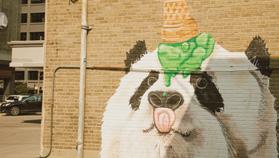
Hall was approached in 2015 by the Fort Wayne Downtown Improvement District to help utilize funds that had been earmarked for a creative project to encourage the walkability of a downtown that Hall describes as “very gray and taupe.” According to Hall, that first installation was just the beginning.

“The art came first, which was followed by this overflow of visitors and then this reinventing of the space that goes beyond the public art,” Hall says. “You could maximize that by putting up seating and allowing restaurants to serve people out of these spaces or allowing people to bring their takeaway to these alley spots.”
While the private sector was initially hesitant, local firms and businesses were still quick to appreciate the value of the impact. Hall reflected, “These leaders know that the young people they need in order to stay competitive were finding these

new spaces downtown enticing and something that was encouraging them to stay or to move to our city. And while they might not have liked every piece of art, they have come to fully understand the economic impact of having this much art in our downtown space.”
You could say the rest is history. What started out as a single project has blossomed into a culture where new developments have begun including future murals in the building plans. Art This Way provides funding to support at least one community-driven mural each year, but the business community is funding others and individual artists are making their own projects. Visit Fort Wayne features an online interactive map to guide people through the rapidly growing collection of installations across the city.
This open invitation to participate excites Fort Wayne-based artist Theoplis Smith III, who goes by Phresh Laundry. Smith speaks to the opportunity to be a bridge for the future of art and the generations who will be making it. Increasingly, this art is moving out of frames and onto the streets, and studies affirm the positive impact this public art is having on communities.
Smith’s proud of the work that’s happening, “Sometimes, you just gotta do something that’s never been done before to get where you need to go. You gotta give yourself permission to be great. We don’t just want to have these witty ideas, these dreams. We want to have tangible, accessible realities.”
Data collected by Americans for the Arts suggests that cities with an active and dynamic cultural scene—public art being a key factor—attract both individuals and businesses. But I think Hall says it best: “It can be difficult to quantify the impact of a mural, a clean alley, a new public park, a music festival, sidewalk improvements, and even the existence of a trash bin, but these elements within a public space impact our overall impression of a community. That matters because it’s our impression of a place that can determine whether we choose to invest ourselves in that place.”
So, the next time you’re near Fort Wayne, make sure you stop by the downtown district to see the murals–and the new Riverfront park and the pedestrian block at The Landing. In addition to, obviously, the Botanical Conservatory and Hyde Brothers Booksellers. ✂

What started out as a single project has blossomed into a culture where new developments have begun including future murals in the building plans.



MARK BRASTER IS A SELFTAUGHT GRAPHIC DESIGNER BASED IN FORT WAYNE, INDIANA WHO SPECIALIZES IN HELPING MUSICAL ARTISTS OPTIMIZE THEIR BRANDS THROUGH MERCH AND PROMOTIONAL ASSETS. BRASTER HAS WORKED WITH ARTISTS LIKE LIL WAYNE, KANYE, DJ KHALED, DMX, YOUNG MONEY AND MANY OTHERS, AND IS CURRENTLY THE LEAD DESIGNER FOR THE ROLLING LOUD MUSIC FESTIVAL. AS IF THAT WASN’T ENOUGH, BRASTER IS ALSO THE OWNER AND FOUNDER OF BRAST STUDIOS, A STREETWEAR BRAND. I BRIEFLY CAUGHT UP WITH HIM TO LEARN MORE ABOUT HIM AND HIS WORK.
POLINA OSHEROV: Growing up in Fort Wayne, where did your love of fashion come from?
MARK BRASTER: My mom was always very particular about this needs to match, or this and that, and it just stuck from when I was a kid. Then maybe my freshman or sophomore year of high school, I made up my mind that I wanted to get into fashion. I had no idea how, but I knew I’d figure it out..
PO : What are some of the challenges of running a fashion brand in Indiana?
MB: I’d love to be able to source fabrics and have the clothing cut and sewn locally. That’s the biggest thing. Also, I love doing oversized prints on shirts and the printers here tell me that they can’t do it. I get it done all the time, just not in Fort Wayne. No one seems to have the right equipment here.
PO : You’re completely self-taught. And you have the aesthetics and the taste, the hustle, and the work ethic, so what do you think drives you?
MB: I just always want more. I don’t want this to come out the wrong way, but I just want to be the best, and the best version of myself. And the more placements, the further I progress, it just literally energizes me and pushes me to go even harder and I’ve always been like that. I ran track, I played football, and I was the same way with that. That’s just how I am.
PO : I understand that you are a guy who is really good at last minute projects.
MB: Yeah. Honestly, the majority of the projects that I’ve been given were completely last minute. And they
always say, “I’m sorry” but, I’m used to it at this point. It is what it is, whatever it takes to get it done.
PO : I think that that’s maybe a small part of your success, right? Because I think that there’s a lot of people who would be put out being asked to work really hard at the last minute and turn down gigs, but you seem to thrive on it.
MB: It is frustrating at times, but like I said, whatever it takes to get it done. I’m willing to do the work. I know that it’ll pay off in the long run, and I feel like that’s the most important thing. You know, it’s easy to focus on the now but the long run is what really matters.
PO : Most successful people I know talk about “paying their dues.” What was your professional trajectory like?
MB: I’ve done a lot of projects for free, and I feel like that played a huge part in getting my name out there, especially being from Fort Wayne. I didn’t have the finances to travel and network, so what I would do is just pick an artist, a band or a clothing brand, look at all their stuff online and try to figure out what they are missing branding-wise? How can I become an asset? Then go from there. I would put some stuff together, shoot it over to them unsolicited via social media, “Hey, here’s something, if you like it, let’s work, and if not, thank you anyways,” and try to build a relationship with them that way.
PO : Talk a little bit about your 2017 Lil Wayne and Neiman Marcus collaboration that you did.
What was memorable about it to you?
MB: For one, it’s Lil Wayne, and I feel like that’s everyone’s favorite rapper. So just even having that opportunity to have been given creative control was huge. And then, of course, the fact that my work was in Neiman Marcus, it showed me, my work is good enough.
PO : I feel like something interesting is happening in Fort Wayne, within its creative economy. There appears to be that magical alignment of when public, private and civic leaders equally care about a thing, at the same time, and as a result you get a swell, or energy around that thing. Is it because of Sweetwater? What do you think it is?
MB: I feel like Sweetwater definitely has played a part in the momentum we’re seeing because they showed people in Fort Wayne what’s possible. I remember when my mom and my stepfather first built our house over here, and Sweetwater was down the street. It was just a small building, and then to see what it is now, it’s crazy. Also, I work in the music industry, and seeing world-famous producers, and musicians, buying equipment from Sweetwater, that feels good. And hopefully, it’s showing the future potential of Fort Wayne.
PO : How do you juggle working on your own brand and then making things for others?
MB: I don’t know, it’s a crazy process. (laughs) I’m always working on my own brand in my own mind, even as I’m working on someone else’s project. I do take way longer working on my stuff versus for a client. A client could call me today and say, hey, we need a collection, this amount of pieces and I can just knock it out. When it comes to my own stuff,
I tend to overthink, and be a little bit harder on myself. But I make it work. I still get stuff out.
PO : What’s been the most creatively satisfying project that you’ve done so far?
MB: I would have to say working with Kanye and the Donda team. I’m used to working alone, so that entire process of working with all these creatives as a team was really eye-opening. Also, seeing the way Kanye thinks and creates, how he approaches projects really helped me as a creative. I stopped overthinking some things and accepted the fact that it’s okay to be inspired by other things.

PO : Where do you see yourself professionally in the next two to five years?
MB: My goal is to have my own creative agency. I still want to design, but I also want to handle the business side and build relationships with bigger brands, bigger companies. The goal with bigger gigs is to share the creativity with the world and obviously, get other creatives out there. I know so many creatives here that don’t have a huge placement, or no one knows who they are but they’re extremely talented, and deserve to get an opportunity to show off their talents.
PO : What’s the biggest challenge with what you do?
MB: The biggest challenge for me has been dealing with industry gate-keepers. People who can identify my talents, know that I’m good at what I do and yet choose to stand in the way of certain opportunities and relationships. Frustrating, but that won’t stop me. (laughs) ✂
“A CLIENT COULD CALL ME TODAY AND SAY, HEY, WE NEED A COLLECTION, THIS AMOUNT OF PIECES AND I CAN JUST KNOCK IT OUT. WHEN IT COMES TO MY OWN STUFF, I TEND TO OVERTHINK, AND BE A LITTLE BIT HARDER ON MYSELF. ”ABOVE Rolling Loud, Project: RLNY 22’ Butterfly Leather Jacket, 2022 RIGHT Brast Studios, Greatest of All Time tee and shorts, Inspired by Michael Jordan , 2021




When I went to the Hermitage in St. Petersburg, if we’re being honest, it was to see the museum more than the actual art. The same could be said for my time at The Getty in LA, the MOMA in NYC, and the National Portrait Gallery in DC. When I go to a gallery or a show closer to home, it’s to see the artist themselves more than the art. This isn’t to say the art isn’t worth the trip or the time, it’s just my honest ordering of reasons. I like going to museums and being with people, and art is the best backdrop for these experiences.
This is about to change for me.
The Long-Sharp Gallery—at the time of writing—is installing Front Page, a collection four years in the making, featuring artists spanning four continents and five decades. The commonality is how these artists have reimagined what’s possible with paper as their medium. Both because, well, paper, and because these pieces are newsworthy.
Gallery curators Nicole Sharp and Rhonda Long-Sharp shared about the origin, evolution, and opportunities of this particular collection with me. We were limited to digital renderings of the work, but their excitement over these pieces was infectious.
Nicole, the primary curator for Front Page, laughed when she said, “Oh, I’m extra jazzed about this one. The gallery’s about getting living artists in front of people who otherwise wouldn’t see their work. That’s a really cool experience for the artists, and that exposure to the work is really cool for art lovers and, you know, people with eyes.”
That said, most of Long-Sharp Gallery’s buyers are from out of state, which poses a unique challenge for the curators who are in the business of selling. Nicole and Rhonda are working to develop additional media to better showcase the pieces to a remote audience.
“It’s worth it,” Rhonda says about the extra work of showing work in Indy. “We always strive to do things that are both different and educational in the sense that you bring some scholarship to the room. With this collection, we also have the opportunity to expose people to things they probably weren’t going to see otherwise. And that’s part of what we feel is our responsibility to the artists and certainly to the young artists given that we have a place where we can do it.”
With Front Page, the story is—of course—the paper. Typically considered a more humble medium, these artists have elevated paper to beauty and precision that transcend conventional understanding of what’s possible. And I cannot wait to see these pieces in real life . In the meantime, we can all hear from a few of the artists themselves in interview with the Long-Sharp Curatorial Team.
LONG-SHARP GALLERY: When/How did you know you wanted to be an artist?

YULIA BRODSKAYA: I never consciously made a decision to be an artist; I just followed the flow of life that began at age five with my parents sending me to an art school and then to a university to get a degree in Graphic Design (as they believed that to be a more reliable way to make a living than just Art). Years later, this life flow brought me into paper art, which started as commercial design work, but eventually evolved into what feels like true Art.
LSG: What is a challenge about working in/on/with paper?
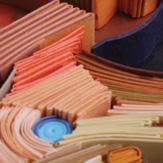
YB: My art practice constantly teaches me to stay in the moment as much as possible. The working process is very slow, so more often than not, it is accompanied by thoughts going in a loop about how long this work takes, whether
the result will be worth the time and effort, and so on. Such mind activity slows down the process and sucks the joy out of it. However, like in meditation, if I don't pay much attention to these thoughts, and instead focus on making one small step at a time, everything changes and there is again joy, simplicity, and peaceful creative flow.
LSG: How has your work transformed in the past 6 months? Year? 5 years?
My work is constantly evolving, even though the medium—paper—is one constant that doesn't change. Over the years, I have moved from very precise/neat and more structured designs to more flowy, organic, free, and dynamic ways of working with paper. In other words, I stopped worrying about every single paper strip and making a “mistake” and began to trust myself and the process. Now I feel the freedom to create without self-inflicted limitations. ✂
“SEESHALL IS
NASHAK II 2022 ACID FREE PAPERS & MOTHER OF PEARL INLAY SIZE: 15.75 X 11.75 IN (40 X 30 CM) FRAMED: 17.5 X 13.5 IN (45 X 35 CM)
LONG-SHARP GALLERY: What is it about working in/on paper that is appealing to you? What do you like about the medium?
JULIA IBBINI: Paper is incredibly strong (particularly given the minute detail I cut it at) and surprisingly forgiving. I've spent much time in recent years figuring out how to sculpt in paper; in some works, I've been able to literally wash (in water) paper cut as fine as lace and still mold it into a sculptural form without it breaking.

LSG: What is a challenge about working in/on/with paper?
JB: In the type of work I do, it's all about patience. I'm one of those annoyingly high-energy people and very impatient in daily life, but with paper I'm forced to slow down, both to plan and develop techniques and then to focus on the actual making of the work.
LSG: Do you have a favorite museum? A favorite city for the arts?
JB: Without a doubt London, and the V&A Museum.
LSG: How has your work transformed in the past 6 months? Year? 5 years?
Longer?
JB: My work shifted significantly in 2016 toward a more tactile, sculptural feel along with much higher levels of detail through use of new machines and algorithms. It has continued to evolve in that direction since then, and there's still a sense of being at the beginning of that journey.
LSG: What is the most used item in your studio?
JB: I've got a huge pinboard on the studio wall with prototypes, samples, and all sorts of different materials and sketches. I refer to it almost daily. Then, of course, there's my beloved laser machine. ✂
"MOTIFS FOR THIS PIECE WERE DRAWN FROM MULTIPLE ANTIQUE PERSIAN CARPETS. I WANTED THE TENDRILS AND FLOWERS TO BREAK FREE OF THEIR SYMMETRY AND GROW OUTWARD TOWARD THE EDGE OF THE COMPOSITIONAS A WAY TO COUNTER THE RIGIDITY OF THE SYMMETRICAL FORM INHERENT IN THE ORIGINAL DESIGN.”

LONG-SHARP GALLERY: When/How did you know you wanted to be an artist?
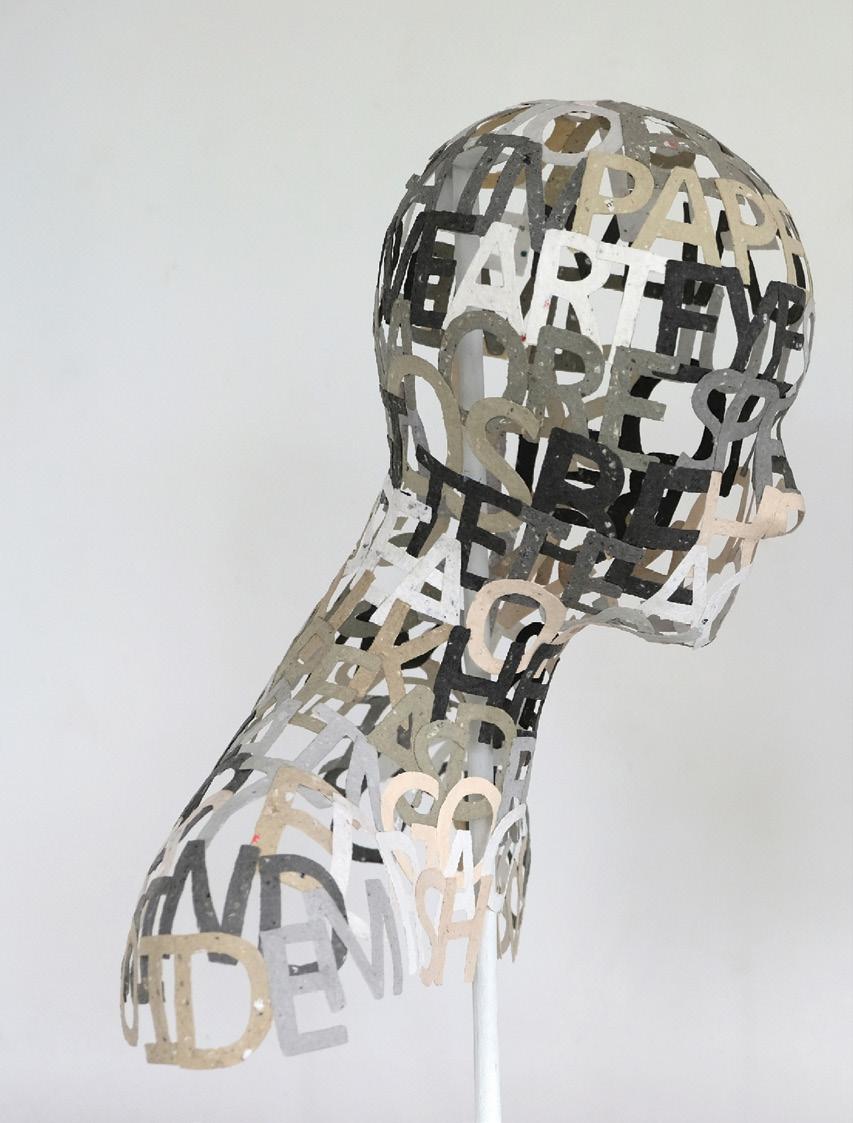
MIRIAM LONDOÑO: It was a process that developed slowly for me. My love for painting and drawing led me to go to University to study Fine Arts, without having a clear idea of what it meant to be an artist. Over the years and with experience, my love and interest for art and what it meant to be an artist has grown stronger.
LSG: (Understanding that you're not limited to paper) - What is it about working in/on paper that is appealing to you? What do you like about the medium?
ML: Paper has been fundamental in the development of my artistic process. It has an immense symbolic meaning in itself, having transmitted and preserved knowledge throughout the centuries. It is a material that possesses enormous resources and possibilities for artistic expression since it can be handled and transformed in infinite ways. After years of working with paper, I continue to be fascinated by its capacity to surprise and evoke emotions.
LSG: How has your work transformed in the past 6 months? Year? 5 years? Longer?
ML: Over the last few months, I am incorporating book and magazine scraps into the paper pulp as a way of adding fragments of reality into my work, as well as a way of adding texture to the paper. Instead of working with plastic squeezing bottles, I am using molds and stencils that allow me to create much thicker and more resistant lines and letters.
LSG: What is a challenge about working in/on/ with paper? Or, if you prefer, is there anything working in/on/with paper teaches you about yourself? About life?
ML: The most important challenge in my paper pulp artworks is to achieve a resistant and strong paper. It involves having an intimate knowledge of the qualities of each fiber I work with and how it reacts to various atmospheric agents. Since working with handmade paper is a long and strenuous process, it teaches me to be patient and disciplined and to have an open mind to all the surprises that might occur during the process. Besides, it forces me to constantly investigate the possibilities of the material with which I work.
LSG: Do you have a favorite museum? A favorite city for the arts?
ML: I love the Tate Modern in London; its venue is impressive, as well as its art collection and the exhibitions they organize on important artists. Also, Amsterdam has wonderful museums like the Stedelijk Museum and the Rijksmuseum. Despite being a small city, it has many galleries where one can see what is happening in the field of the latest art. ✂
“DIALOG I REPRESENTS OUR MINDS: AN UNLIMITED AND CONSTANT FLOW OF WORDS, THOUGHTS, IMAGES, AND IDEAS, OFTEN REPETITIVE AND UNSTRUCTURED, BUT ALSO CREATIVE, ALLOWING US TO ENGAGE IN DIALOGUE WITH OTHERS.
DIALOG I IS PART OF THE MONOLOGUES SERIES, WHICH IS COMPRISED OF BODIES AND HEADS MADE UP ONLY OF LETTERS. LOOSE LETTERS FEATURE AS A LATENT POSSIBILITY FOR THE IMAGINATION TO CREATE WORDS FROM THEM, AND FROM THESE WORDS, COMMUNICATE STORIES AND DREAMS WITH OTHERS.”
DIALOG I 2022 HANDMADE PAPER
LEFT HEAD: 17 X 16 X 11 IN (43 X 40 X 28 CM)
RIGHT HEAD: 17 X 17 X 12 IN (44 X 44 X 30 CM)

AMERICA’S
1990
“I USED A PAPER GROCERY BAG FROM THE A&P (ATLANTIC & PACIFIC) SUPERMARKET IN NEW YORK, THE SLOGAN ON THE BAG READING: ‘AMERICA’S CHOICE.’ (AN APPROPRIATE MESSAGE FOR ITS RETURN TO AMERICA FOR THE SHOW AT LONG-SHARP GALLERY.) THIS WORK MADE WAS MADE IN 1988 WHILE I WAS LIVING IN A SMALL LOFT, A BLOCK SOUTH OF CANAL STREET, THE STENCILED LYRICS TAKEN FROM THE ICONIC SONG ABOUT NEW YORK BY FRANK SINATRA, ENCAPSULATING THE CONSISTENT BUZZ AND VIBRANCY, WITH THE EGALITARIAN POSSIBILITIES AFFORDED TO ANYONE, AND THE IMPORTANCE OF ‘MAKING IT’ IN NEW YORK, THE CITY THAT CAPTURED MY HEART.”

LONG-SHARP GALLERY: When/How did you know you wanted to be an artist?
MOIRA CAMERON: From my perspective, this is a strange question, as I would have had to have thought I wanted to be something else. My parents were both artists, as was my grandmother. It was the only thing I knew. I was always going to be an artist.
LSG: What is it about working in/on paper that is appealing to you?
MC: I particularly liked the paper bags to work on. They came with ready-made images and slogans. I liked that they were recycled and that the paper was slightly waxy and was good to work on. The bags are also everyday objects, normally discarded. But for me they hold treasured memories and are mementos from places I visited.
LSG: What is a challenge about working in/on/with paper?
MC: The paper bags show me how everything has a beauty. Someone has designed and manufactured something as simple as a utilitarian paper bag. For them to exist, they have undergone many processes, and then are disregarded and forgotten. I could suggest this is a life metaphor…!
LSG: How has your work transformed lately?
MC: I had an extensive break from artwork. Since reviving my practice, I find just working through ideas is transformative. One work leads to multiple other possibilities. ✂
“AURORA IV IS A VIBRANT COMPOSITION THAT BATHES EACH PHOTOGRAPH ON THE ACCORDION BOOKS IN WARM COLOR GRADIENTS THAT ARE DIGITALLY PRINTED ON JAPANESE PAPER. IN ALL OF MY WORKS IN THE AURORA SERIES, I PAINT THE BACK OF EACH PIECE WITH A FLUORESCENT NEON RED THAT REFLECTS AND GLOWS AGAINST STARK WHITE WALLS. FOR ME, THIS COLOR CALLS TO MIND BOTH THE NATURAL – THE PINKISH-ORANGE LIGHT OF DAWN – AS WELL AS THE HIGHLY ARTIFICIAL – THE NEON ORANGE OF TRAFFIC CONES AND HAZARD TAPE.”
LONG-SHARP GALLERY: When/How did you know you wanted to be an artist?
NICOLE PIETRANTONI: I think I’ve always been an artist, but I didn’t start believing in my work until I was in college where I had professors and a community that supported my fledgling art career. It wasn’t until then that I realized that being an artist was even something you could do with your life. We are all creative, but somewhere along the way our culture “detrains and unlearns” the creative parts out of us. I feel lucky to have had a family and network of friends and professors who saw some spark in me and encouraged me to keep making things. Now I can really see that spark in myself and know that making art is one of the most meaningful and joyful things I can do with my life.
LSG: What is it about working in/on paper that is appealing to you? What do you like about the medium?
NP: Paper has been my primary medium from the beginning. Even when I am making prints, the structure and sculptural potential of paper is a throughline in my work. For me, I like making paper-based sculpture that is loud, boldly colored, hard-edged, and often monumental in scale. Working this way defies the ways we traditionally think of paper (and paper-based artists) as making soft, delicate, and diminutive work.
LSG: What is a challenge about working in/on/with paper?
NP: Working with paper is a lesson in paying attention. As an artist, I think this is at the core of all our work – to be embodied and pay attention to the world around us and the materials in our hands. Paper is an organic material

that responds to heat, light, the touch of our body. Paper circulates throughout our lives often unnoticed. We toss away or recycle bills, receipts, labels, tags. We pay attention to the content it carries, but rarely do we think much about the material itself. The material— organic, pliable, infinitely malleable, and infinitely scalable—is part of the work. Paying attention to the material and all its infinite potential is an ever-present teacher.
LSG: Do you have a favorite museum? A favorite city for the arts?
NP: The Venice Biennale is my favorite art event – it’s like visiting multiple museum exhibitions and getting to see hundreds of artists all in one walkable area. It’s exciting to see different curators’ visions and how the same spaces change from one Biennale to the next. Visiting the Biennale makes me feel nourished and liberated as an artist – it reminds me that there are so many different ways to be an artist and such a variety of ways to make art today.
LSG: How has your work transformed in the past 6 months? Year? 5 years? Longer?
NP: My work has changed a lot over the past decade, and yet I can also see threads that remain (like working modularly with paper and focusing on human’s relationship to the natural world). I went from making installations out of shadows cast by screenprinted glass (which was all on a grayscale) to creating massive paper-based installations of wildly colorful accordion books. At the heart of the work has always been an interest in light, shadows, and color. ✂

INTERVIEW + PHOTOGRAPHY BY LIAM ROGERS


STYLE BY OLIVIA BRAUN IN PARTNERSHIP WITH APPAREL INDUSTRY BOARD, INC.
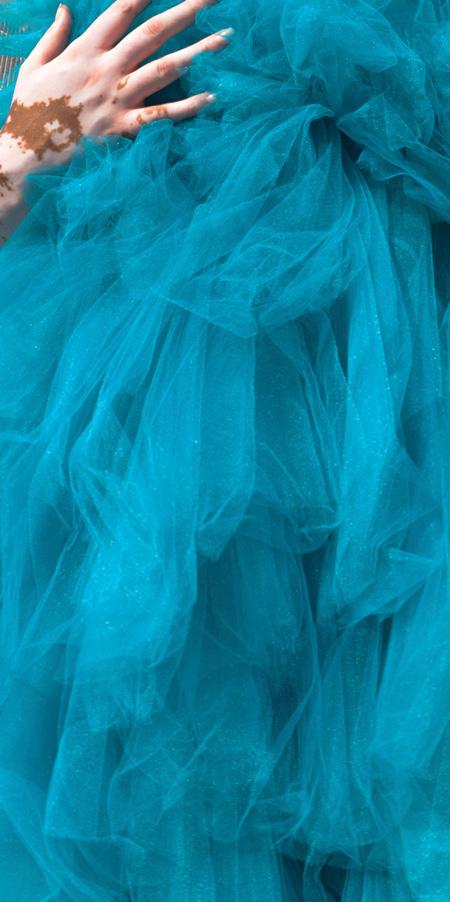
HAIR & MAKEUP BY KALEB TALARICO
ALL TALENT PROVIDED BY 10 MGMT
YOU WON'T BREAK HER SOUL
SINCE FIRST BEING DISCOVERED AT A PATTERN MAGAZINE MODEL SEARCH IN 2019, INDIANAPOLIS-BASED MODEL JANAY PROSPERS HAS BEEN FULFILLING THE DUTIES OF A MODERN SUPERMODEL. SHORTLY AFTER THE SEARCH, SHE SIGNED WITH CHICAGO'S 10 MGMT AND HAS NEVER LOOKED BACK, GAINING REPRESENTATION IN NYC AND LA WITH TOP AGENCY ONE MGMT AND BOOKING JAW-DROPPING JOBS LIKE RIHANNA'S 2021 SAVAGE X FENTY RUNWAY SHOW. BLACK, CURVY, AND SMATTERED IN VITILIGO SPECKLES, SHE'S KICKING DOWN THE RELENTLESS MODELING INDUSTRY DOORS ONE AT A TIME. I CAUGHT UP WITH THE DEBUTANT—WHO NEVER LOSES HER SIGNATURE, INFECTIOUS SMILE—ON A SIZZLING JULY DAY.
LIAM ROGERS: Let's do a quick fit check. What are you wearing right now?
JANAY PROSPERS: I’m currently wearing my favorite leather pants with my white ribbed tank top and Jordan Retro Ones. If it’s comfy and cute, I’m wearing it!
LR: What made you want to attend the initial model search back in 2019?
JP: I knew that if I wanted to go farther with modeling and actually make a career out of it, then I’d need to put myself in front of the right people. When I saw the Instagram post promoting the model search, I had only seen it a few hours or so before it started. I dropped everything I was doing and went for it! You can’t wait for something to be handed to you. I’ve always been a go-getter, and I saw this as an opportunity of a lifetime and my chance to shine my light.
LR: Tell me about your very first job after you got signed.
JP: The very first booking that I landed with 10 MGMT was with Akira. I’ll never forget—I had to be in Chicago on June 30, 2020. At the time, I was working day and night shifts trying to get on my feet and I was sleeping in my car, but I never told my agents because I didn’t want them to think I wasn’t ready. My situation did make it very difficult for me to travel to jobs out of town because I had no money, but I worked and fought really hard to make it happen. I refused to let that be my story. So I mustered up enough money to at least make it there, and I went! It was the beginning of an amazing turnaround for me. As a model, you have to get out there in the field. That's how you begin to grow and more brands begin to see more of you. I believed that if I pushed through, gave it my all, and never gave up no matter how hard it may be, then it would all pay off. And it truly has.
LR: What's your morning routine to prepare for a big shoot day?
JP: My biggest priority before a shoot is to be stress free so that I can perform at my best. So that means getting my model bag and outfit together the night before, making sure to have my nails and hair prepped in advance, and then
having a nutritious breakfast or coffee to give me energy. Preparedness is key in this industry. If I’m not prepared then I’d have to rush, hence starting to sweat, and then getting anxious because I’m drenched in sweat. It’s not a good look. Be prepared!
LR: Speaking of preparing—how did you hold it together when you met Rihanna and performed in the show?
JP: Rihanna is such a sweet soul. We met for the first time at her premiere party for the show. It’s a funny story actually. I began to approach her as my agent spotted her hanging out around the bar at the rooftop. As I was walking up, she hadn’t seen me yet, and her bodyguard diverted me, saying “No. She’s trying to chill.” I understood because duh, it’s Rihanna! Then I went back to the dance floor and was taking an Instagram video when she popped up behind me. She immediately welcomed me with open arms and told me that I “killed it” in the show. I was overwhelmed with so much gratitude and disbelief, I was at a loss for words. I gave her a big hug and thanked her for the opportunity.
LR: This leads me to the question I've been dying to ask. What was the process of getting booked for Savage X Fenty's show? Do you have any favorite moments?
JP: Around this time, 10 MGMT became my mother agent and helped me in the process of signing to One Management in New York. It was such a surreal moment. It felt like another big milestone and step in the right direction, just as signing in Chicago felt two years prior. A month after signing with One Management in New York, Savage X Fenty requested me for the booking, but it wasn’t confirmed just yet. After sending them a video of my runway walk, my agent said they fell in love. They then confirmed me a week before flying me out to LA, and the rest is beautiful history.
LR: Who or what is your current inspiration?
JP: You could say my inner child inspired me to start modeling. I’ve had vitiligo, an autoimmune skin condition, since I was thirteen years old. That was such a tough age to be the elephant in the room. I would be stared at all day long and get
so many rude comments thrown at me. Kids say whatever comes to their mind, and I wanted to be a part of the change of beauty standards, especially in the modeling and fashion industry where we tend to set the trends and call the shots of what’s “cool.” I didn’t want another kid growing up scared to come out of the house, or skipping class to avoid bullies, or simply hating to see themselves in the mirror like I did for a while as a teenager. As I got older, I actually realized that the bullying doesn’t stop with kids. Adults do it also. And adults can also have insecurities. I do it for everybody who needs to see that representation. It does something to see someone like you on billboards, in ads, in magazines, in stores, and many other outlets doing their thing unapologetically. That right there, I see so much beauty in.
LR: What would you like to see more of in the industry?
JP: I would like to see more diversity in high fashion as well, not just commercial modeling. Believe it or not, there are still models starving themselves and killing themselves to fit the outdated mold of what a model should look like. I was taught that when there’s not a seat at the table you build your own, so I say we shape the industry and not let it shape us. We are setting the tone for the next generation.
LR: What advice would you give for someone looking to break into the industry?
JP: Expect nos and be okay with that, because it only takes one yes. A modeling career isn’t built overnight. At no point in history has that been done. Be diligent and don’t stop until you’re fulfilled, but also be patient and kind to yourself. And one more thing: figure out your “why.” If you don’t know why you want to do this, you may feel empty in the long run because you had no purpose in it. Let your “why” drive you and let your story enlighten you. Remember this saying: “Talent will get you through the door, but character is what will keep you there.”
LR: What does the future hold for you?
JP: I know that my future is joy, it is gratitude, it is success, it is filled with love, it is prosperous. I have many goals that I’m working towards, but God always seems to exceed my expectations. All I can say is: just you wait! ✂
“I wanted to be a part of


Photography by Wil Foster
Photography assistant: Katie Freeman
Style by Katie Freeman
Hair by Dee Lanee & Colleen Konowitz (Aesthetic Artist Agency)
Makeup by Danelle French & Colleen Konowitz (Aesthetic Artist Agency)

Models: Lucille F. & Mallory B. (Heyman Talent Agency)
Design by John Ilang-ilang
It is an ever-so-delicate dance
between opposite elements that creates balance.

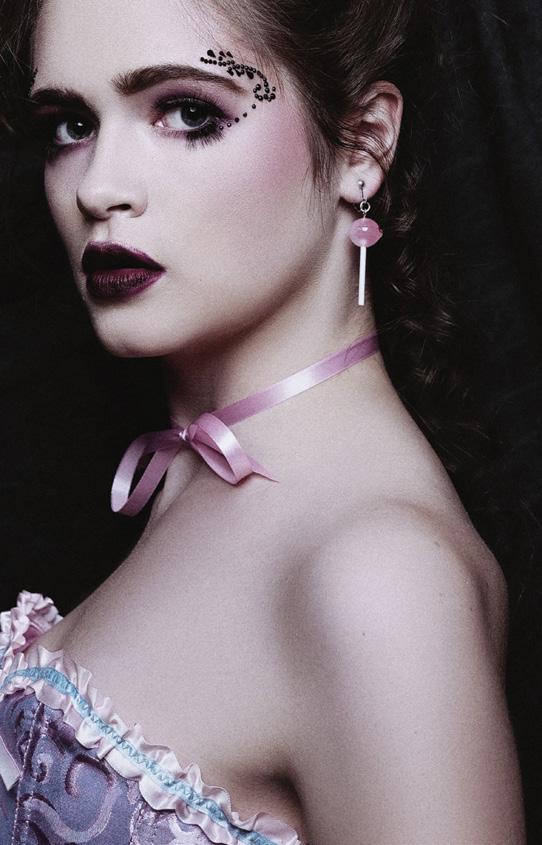



then be satiated.



AILITHIR MCGILL SHARES HOW NICKEL PLATE ARTS BUILDS COMMUNITY

 WORDS BY ALEXA CARR PHOTOGRAPHY BY POLINA OSHEROV
WORDS BY ALEXA CARR PHOTOGRAPHY BY POLINA OSHEROV
“I want to encourage people to come to Hamilton County and explore the really amazing arts assets that we have here. There's always some creative, fun event going on that you can get involved with. Then, you’ll start meeting new neighbors and friends and finding reasons to come back to Noblesville and Fishers.”
— AILITHIR MCGILL EXECUTIVE DIRECTOR OF NICKEL PLATE ARTSIf you’ve ever driven through the Fishers or Noblesville area, you are no stranger to the name Nickel Plate. There’s the Nickel Plate District, Nickel Plate Amphitheater, Nickel Plate Arts; it all goes back to the Historic Nickel Plate Railroad. Though the similar names may be confusing at first, they all share a similar goal: to work together to build and engage a thriving arts community in the area. Executive Director of Nickel Plate Arts, Ailithir McGill, shares Nickel Plate Arts’ role in community building and the state of the creative economy.
Nickel Plate Arts is a 501(c)(3) arts and culture nonprofit that believes “by creating connections, art has the power to shape—even define— communities.” They have been dedicated to that mission for a decade now, celebrating their tenth anniversary this past April. Programming for Nickel Plate Arts happens in the form of galleries, classes, and annual events.
As stated in their mission, community drives everything that Nickel Plate Arts does. McGill confirmed this sentiment, describing the community she hopes to help foster in Hamilton County.
“It’s about both generating a sense of belonging and celebrating the things that make people want to belong here,” McGill says.
McGill spoke about the incredible value that the arts bring to communities. She feels it is easily overlooked because of the intangible and difficultto-quantify benefits arts have on society and the economy. She gave the example of how tourists may not specifically book a hotel to see a Nickel Plate exhibit, but they certainly may decide to stay an extra day because of it. This contributes to Hamilton County and Indiana’s broader creative economy.
There is this intrinsic correlation between artists and small business owners; many artists

are small business owners themselves to sell their work. McGill talked about how many of those who are not artists often forget that there is more to being an artist than just creating art. Through time, Nickel Plate Arts has found that the more they can support art and business, the stronger creative economy they can build.
This is the basis of the Business of Arts courses that Nickel Plate Arts hosts. These courses focus on elements like tax regulations, accounting, and marketing—the elements that help lead artists to financial success. These are not restricted to Noblesville and Fishers community members; artists across the state can benefit as well through courses available online and in-person.
Though Nickel Plate Arts hosts courses like this, they knew that they’d be interested in getting involved in the Indiana creative economy in a larger way. The On Ramp program ended up being the answer to this desire and helped to further address needs in their community. On Ramp is an entrepreneurial incubator for artists hosted by the Indiana Arts Commission. Since the beginning of the On Ramp program, Nickel Plate has been supportive of it and has had a strong partnership with IAC.
In 2022, Nickel Plate Arts had the opportunity to host the entirety of the On Ramp Program. McGill says that hosting the On Ramp program was an excellent way to introduce artists from across the state to all that the Nickel Plate campus has to offer. Though the On Ramp Program will be held at different locations each year, McGill shared that Nickel Plate will still be involved and is excited to network with graduates year after year. She also hopes that Nickel Plate Arts can serve as a landing
pad for some of the graduates: a place to take classes, show work at galleries, or connect with other artists.

To serve as a hub for artists of all levels, Nickel Plate Arts knows that they must offer a variety of programs and opportunities. One of these opportunities is The Judge Stone House Gallery, where artists of any experience level can submit their pieces to be showcased. They also have other member-only galleries where artists can exhibit and sell entire collections. Nickel Plate Arts’ support for artists goes beyond the physical space. During the height of the COVID-19 pandemic, the organization continued to support artists in a safe way by creating digital art galleries. This new initiative continues to be successful and allows art to reach a broader audience and customer base.
Ultimately incorporating working artists into activities that the community wants to participate in led to what is now one of McGill’s favorite events, “Welcome to Fairyville.” What started as a tongue-in-cheek idea to celebrate Earth Day, quickly turned into a beloved community event and robust partnership between artists, businesses, and consumers. There are art competitions, public performances, and businesses are encouraged to have fairy-themed products and engagements. This past year, twenty-four local businesses participated in the event.
McGill looks forward to seeing how Nickel Plate Arts can continue to build and grow events like these and how they will affect the creative economy. She hopes that in the next five years, Nickel Plate Arts will acquire more space to be able to support more artists and expand their programming. ✂

“IT’S ABOUT BOTH GENERATING A SENSE OF BELONGING AND CELEBRATING THE THINGS THAT MAKE PEOPLE WANT TO BELONG HERE”

WORDS BY ANNE LAKER AND SHAUTA MARSH PHOTOGRAPHY PROVIDED BY ARTISTS

EDUARDO LUNA IS AN INDIANAPOLISBASED SOCIAL PRACTICE ARTIST, CULTURAL PROMOTER, ADVOCATE FOR MEXICAN IDENTITY AND LATINA/O/X/E CULTURE, AND FOUNDER OF THE NON-PROFIT ARTE MEXICANO EN INDIANA (AMI). IN FALL 2022, AMI IS BRINGING THREE CONTEMPORARY MEXICAN ARTISTS—ILLUSTRATOR DANIELA MARTIN DEL CAMPO, PAINTER MIGUEL CASCO, AND DANCER ANDREA GARAY—TO SHARE THEIR WORK WITH INDIANAPOLIS AUDIENCES AND HIGH SCHOOL STUDENTS.
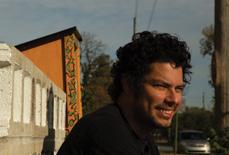
Since 2012, Luna has been curating events featuring Mexican and Latina/o/x/e artists for cross-cultural audiences. Though not an activist, Luna was compelled to launch AMI in 2020, in response to an American president who repeatedly denigrated immigrants. AMI’s mission is to encourage and promote Mexican art, music, and culture in Indiana by organizing and promoting public cultural events, often as collaborations. Luna is by turns a booking agent, partnership catalyst, and much-needed cultural educator.
Luna hails from the state of Guerrero, the city of Acapulco, in the Costa Chica region of southern Pacific Mexico. As a child, he and his parents and brothers would travel to rural towns for traditional festivities. The big sounds of brass, bright costumes, exuberant dance and street pageantry made a lasting impression on him. This was Luna’s first contact with traditional Mexican cultural celebrations, often mixed with European religious traditions. In his household, he was surrounded by creative people, including a brother who carved wooden figurines and toys, and another brother who was gifted at drawing. Luna knew he too wanted to do creative work.
At age 14, Luna’s family migrated to central Illinois, where his father got a job at a broom factory. In high school, Luna enjoyed art classes and the encouragement of an art teacher. He earned a B.A. in Media Arts & Science from IUPUI in 2009, but soon realized he did not want to spend his career sitting in front of a computer editing videos. He turned to the hospitality industry, home to many starving artists.
After working in the industry, he met his future wife, Emma Mahern, and moved to the Pilsen neighborhood of Chicago, incidentally, not far from the National Museum of Mexican Art.
After two years, he and his wife returned to Indianapolis (her hometown) so she could attend law school while Eduardo worked at the cafe inside the Eiteljorg Museum of American Indians and Western Art, as well as a bar called Locals Only. There, Luna had a coworker who would ask to book bands on slow nights. In 2012, Luna booked his first show and started a series called Espanglish Night, hosted by a character of his creation named El Camaron Electrónico [the Electronic Shrimp], Luna’s masked luchador [wrestler] alter ego.
Like many kids coming of age in the late 80s and early 90s, Luna loved lucha libre, professional wrestling-as-performance (Love Machine was his favorite wrestler). Creating El Camaron Electrónico allowed Luna to be on stage with anonymity and freedom while promoting the work of local Mexican musicians at Espanglish Night, which moved to various bars around Indianapolis and began to receive media coverage. Around this time, Luna saw a promotion for Herencia, an art show curated by Indianapolis designer Daniel del Real. Del Real and Luna, along with Nicole MartinezLeGrand, joined forces to form the arts production group Nopal Cultural.
In 2013, still working part time at the Eiteljorg, Luna offered to assist the museum with programming. The acts he booked brought a new audience and a good turnout, building trust with the Eiteljorg. By 2014, Luna was helping to expand the museum’s Día de Muertos celebration with more elements, vendors, partners. Every year since, Luna has curated a more elaborate event. It’s now one of the Eiteljorg’s major annual programs and a free admission day. Programming Día de Muertos at a large institution like the Eiteljorg allowed Luna to practice his cross-cultural alchemy on a large scale: making authentic Mexican cultural experiences easily and joyfully available to both immigrant Mexicans looking to reconnect with their roots, and North Americans experiencing the traditions for the first time.

This year, a trio of artists from Mexico selected by Luna will cross-pollinate arts audiences in Indianapolis. October 10 to November 4, 2022,
Luna hosts Daniela Martín del Campo as guest curator for an exhibition as part of Día de Muertos at the Eiteljorg. Del Campo is a Mexican artist specializing in editorial and children’s book illustration. She brings some of the folklore of Mexico to life through her color-saturated images. She has worked for The Washington Post and publishers such as Penguin Random House, Workman Publishing, Edelvives, and Planeta.
Since 2014, Luna has partnered with Big Car Collaborative on gallery shows, community programming, and placemaking. Big Car opens an exhibition of work by Mexico City-based artist Miguel Casco at Tube Factory, October 7 to November 28. Casco’s Send Nudes is a collection of watercolor and gouache portraits, referencing collective vulnerability and everyday eroticism. Since 2018, Casco has invited people to share nude self-portraits with him through open calls. He then transfers them to painting, “to see through the eyes of the person who sends them and to portray the intimacy they share,” says Casco.
With degrees in both plastic arts and information design from Universidad de las Américas Puebla, Casco’s selfie archive and other work explore the influence of technology/digital/media on shared intimacy. He is deputy director of Museo de la Cancillería [Museum of Foreign Affairs] in Mexico City, and founder of Atelier Mesones, a space dedicated to drawing from live models, and lagalerí_a, a set of projects focused on the teaching, reflection and dissemination of visual arts.
Thirdly, Luna and AMI partnered with Indy Movement Arts Collective for a series of workshops and a performance with Mexican dancer and choreographer Andrea Garay. She performed The crushing weight of absence, a work-in-progress solo dance piece probing the ambiguous qualities of loss of a friend, an object, a dream, a belief, or the self. Garay is co-director of Nómada Proyecto Escénico, a multidisciplinary dance collective in Mexico City.
Bringing three world-class contemporary artists from Mexico City to Indianapolis is all part of Eduardo Luna’s vision for infusing the work of Brown culture-bearers across the art scene. Says Luna: “My goal is that Hoosiers develop a new perspective on the Mexican people and see the value of the culture we contribute to Indiana.” ✂
“My goal is that Hoosiers develop a new perspective on the Mexican people and see the value of the culture we contribute to Indiana.”
DANIELA MARTIN DEL CAMPO
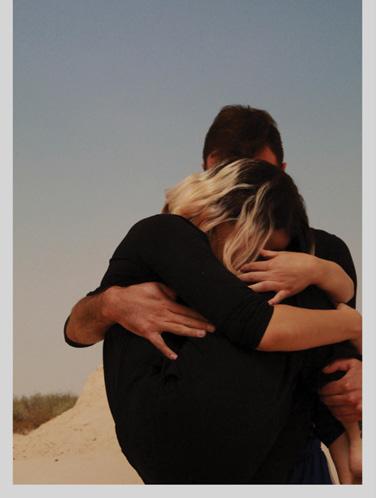

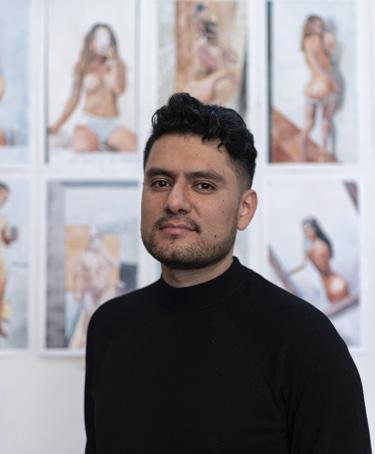

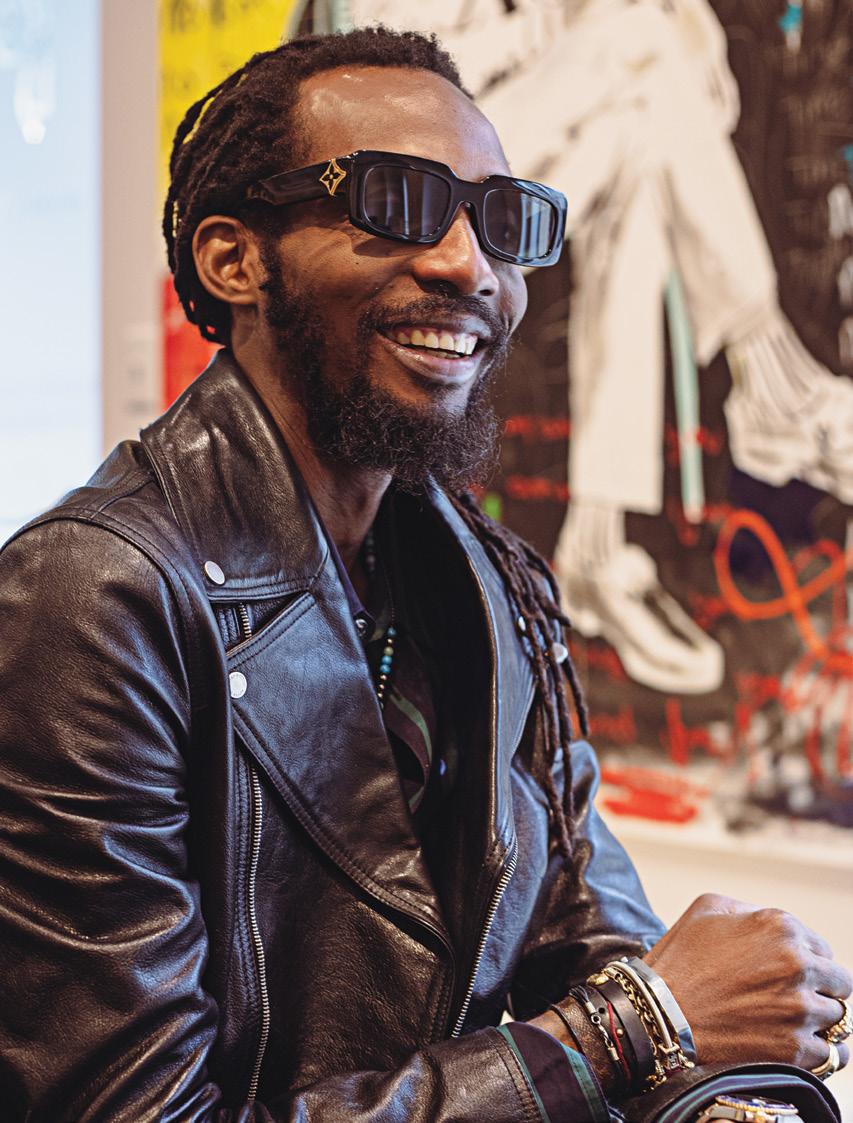

The first time I laid my eyes on a Móyòsórè Martins original piece of art was at the BUTTER Fine Art Fair. I snuck in through the back of the new Stutz car museum space to see first-hand how the installation was coming along. I turned the corner, and was immediately transfixed by the sight of an art piece still wrapped in clear plastic, leaning on one of the movable art walls. It was a vibrant abstract with blues, yellow, greens, and reds that demanded to be looked at. Even though I couldn’t make out the details through the plastic, there was something about the mix of colors, shapes, and scribbles that spoke to me. “I love that!” I said out loud to no one in particular. I was in a rush, and didn’t take the time to find out the artist behind the art, frankly not giving the painting any more thought. That is until I received an email reminder of a new show opening at one of my favorite contemporary art galleries in the whole country–the Long-Sharp Gallery.
Opening tonight at Long-Sharp Gallery: Móyòsórè MartinsSeen, the title of the email read. I opened the email to find out which incredible artist gallery owner Rhonda LongSharp and her daughter Nicole were bringing to Indy this time, and what did my incredulous eyes see, but a photo of the very painting leaning on the wall back at the Stutz. Not only that, but it suddenly dawned on me that this Móyòsórè was none other than the Nigerian-born, NYC-based artist Moyo whom we had already planned on interviewing for the magazine. I had planned on assigning another writer to chat with Moyo, but at that moment decided that I had to meet the man myself.
POLINA OSHEROV: Welcome to Indianapolis! How are you enjoying your visit, and the response to your work?
MÓYÒSÓRÈ MARTINS: It’s overwhelming. There’s a sense of fulfillment that comes with people understanding what you do and seeing them relate to what you create. I think that fills a hole, but I’m not really an in-front person. I’m very laid back. I don’t go out, no parties, none of those things. I love being around my family and that’s about it, but this whole being the “celebrity” in the room thing still feels surreal every time and I don’t take anything for granted. So grateful.
PO: I know I’m not the first to notice, but people of Nigerian descent seem like a very special group. I know so many successful Nigerians–fashion designers, real estate developers, startup founders, attorneys, writers. Why do you think that is?
MM: I appreciate you noticing that. Nigeria as a country has been through a lot and when you’ve been through a lot, that experience shapes you and gives you an edge and that edge can translate into having a drive. I think Nigerians are naturally goal-obsessed people because of their background and history. Life in Nigeria is not easy or simple. Growing up there, then moving to a country like America, provided me with a sense of freedom. I can’t speak for everybody, but the few people I know, including myself, we’ve really been through a lot of difficult things. Being here makes us want to push through.
PO: One thing I know about Nigeria is that becoming an artist, or having a career as a creative, is frowned upon. Yet here you are. How did that come about?
MM: I’ve been painting since I was a little boy–crayons,
pencils, illustrations, and drawing on my friends’ books in class. I’d get in trouble doing that because I went to a school that was heavily focused on sciences from the age of three. Physics, chemistry, math–I was expected to learn all of it, but it just wasn’t for me. Plus all my friends were in arts classes, so I’d just go play with them, draw with their pens, but then I couldn’t even take the sketches home because I’d get in trouble. Still, I never stopped drawing and doodling. It wasn’t until I got to America that I started painting on canvases. I finally had my first taste of creative freedom to explore and do whatever I wanted to do without any setbacks, objections, or other people’s opinions on what I should do with my life.
PO: Being free to be yourself. Is that part of the reason why you left Nigeria?
ABOVE
RIGHT
MM: Yes. The environment wasn’t working for me anymore. I wanted more. I wanted to do more. I wanted to grow, but the soil wasn’t fertile. It was like trying to grow pineapples in a place that can’t grow pineapples. I wasn’t fitting in. It’s like my life was on a repeat loop, yet I knew it could be different, better. I could be better. Even though I had a comfortable life in Nigeria–freedom, friends, a beautiful, tropical paradise with good food, and good fashion–I was stuck, I wasn’t growing, and I knew it.
PO: It takes a lot of courage to leave your homeland for a completely different continent. What was that like?
MM: My mom brought me here.
PO: Shout out to mom!
MM: Yes. My mom knew. She saw how unfulfilled I was. She could tell that I needed and wanted growth, but couldn’t accomplish it there. I was very naïve, very wayward. Actually, I was the black sheep of the family with tattoos, dreadlocks, and my views were way different from the rest of my family.
PO: Coming to America when you were twenty-nine must have been quite a culture shock. How did you handle it?

MM: Honestly, I didn’t like it at first. It was hard. I’ve been around for a minute now, but I still speak differently. Imagine when I first arrived, people were like, “You’re not from here.” Not at all, like even people that look like me. Also there was this feeling of: why did it take twentynine years to come here? The culture, the quality of life, the opportunities here are like nowhere else. I wasted so much time.
Early on, I had some tough moments. I was working backto-back shifts as a security guard, getting off at 4 a.m., and it was lonely. I came here with two pairs of shoes, two jeans, two shirts, and a backpack. That’s it. It was cold here, and I couldn’t afford a jacket or a good pair of boots. I wanted to go home, but when I called my mom and told her I wanted to come back to Nigeria she told me if I did that’d be it for me. That conversation was everything. It was an eye opener and I had to man up and stay.
“I TEND TO SEE COLORS AND THINGS VIVIDLY. I’VE ALWAYS GRAVITATED TO COLOR, AND I LOVE HOW COLOR CAN SPARK CONVERSATIONS AND EVOKE EMOTIONS.”
PO: Your art is filled with personal references, almost like a visual diary. Good times, bad times, depression, exhaustion, obsession, joy. You are essentially in every painting, either figuratively, or hiding in plain sight. There’s a rawness to the work. It’s like you’re wearing your heart on your sleeve. How do audiences respond to this type of vulnerability?
MM: I’m not really sure. People take away what they take away. I did overhear these two women talking about my work one day. I was standing right behind them and they either did not see me, or just didn’t know who I was but one of the ladies was talking about my work to the other lady as if she knew me, so I just stuck around to listen...
PO: You were eavesdropping!
MM: Yeah. [Laughs] And at the end of the conversation, the one lady was like, “This artist is probably pretty old,” and I had to step in and tell her it was my work. She didn’t want to believe me. [Laughs]
PO: You’re an old soul, then!
MM: I think so! My dad was older when he had me, and I grew up around my mom and my grandparents. My dad was also a collector, loved mid-century modern furniture, and artifacts so aesthetically I’m pretty stuck in that era.
PO: Tell me about your use of color, it’s so vibrant.
MM: I tend to see colors and things vividly. I’ve always gravitated to color, and I love how color can spark conversations and evoke emotions. I developed my own technique of composing and manipulating the colors and making them work together. There’s a way you can wear colors or make vivid colors appear very, very calm. Also, I like to paint in very low light, almost in the dark actually. So in my studio, I probably have about twenty different lamps that create spots of light, and I paint just using those lamps.
PO: Sounds like you have quite a lamp collection.
MM: Yes! I collect all these different antique and vintage lamps from around the world and they all have different hues to them. The hues help with how I see color.
PO: How does growing up in another part of the world impact your aesthetic?
MM: I think my aesthetic transcends geography, yet all my pieces contain Nigeria because that’s where I’m from. At the same time, all of my pieces are relatable because there’s no box, no label, and no specific geographic placement.
PO: Are you still the black sheep or have you vindicated yourself?
MM: I’m not sure. I come from a very, very big family. I haven’t seen many of them in a very long time, and most of them still see me as the “old” me. They haven’t seen the growth. But being away from the negativity of being seen as the black sheep has been good for me.
PO: One of your pieces is being shown in BUTTER. What are your thoughts on participating in what might be the
country’s only fine art fair for Black and Brown artists?
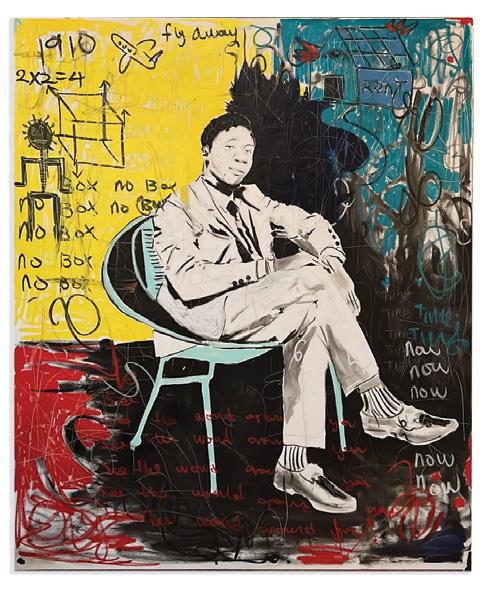
MM: It’s a privilege. It’s amazing. I’m very grateful and excited to see all the other artists, network, and see what they have going on. And for them to see my work.
PO: What’s next for you?
MM: I can’t answer that because I’m just getting started. I think being successful is a progression. It took me a long time to get here, but nothing happens by mistake. I was in America almost six years before I started painting full-time and you know what that means? A lot of depressed nights and doing something every day without knowing what’s going to come from it. You need to be a very stubborn person to stick to your plan. I didn’t speak to my mom for two years because she didn’t respect me as an artist. She told me to go get another job. Everybody I knew backed away from me, but I had a clear vision and didn’t stop. So, I’m just going to keep painting, and staying in my zone and we’ll see what happens. ✂
WORDS BY PHILLIP BARCIO PHOTOGRAPHY PROVIDED BY BIG CAR COLLABORATIVE

WHEN NASREEN KHAN IMMIGRATED TO THE UNITED STATES IN PURSUIT OF AN ACADEMIC CAREER, SHE NEVER IMAGINED SHE WOULD END UP MAKING HER LIVING IN THE ART FIELD. LIKE SO MANY, KHAN ADAPTED HER LIFE PLANS IN THE WAKE OF THE COVID-19 PANDEMIC. NOW, THIS FORMER COLLEGE-PROFESSOR-TURNED-ARTIST FINDS HERSELF WITH A MOST UNLIKELY COMMISSION: TO CREATE A 15 FOOT BURNT WOOD ALTAR FOR THE CHICKEN CHAPEL OF LOVE, A NEW SPACE FOR INTIMACY RITUALS ON THE SOUTHSIDE OF INDIANAPOLIS, WHERE PEOPLE CAN GATHER IN THE COMPANY OF CHICKENS TO EXPRESS THEIR VOWS OR MEDITATE.
From start to finish Khan has a hand in the altar’s creation. The sycamore tree she used for many of the pieces was milled out on the Eastside of Indianapolis and she finds much of her wood along the banks of the White River. She built a kiln in her backyard to dry the wood then worked with fellow artist Jason Peter Gray to plane and sand the panels. At the center of the imagery is Khan’s meditations on the divine feminine.
Located at Tube Factory artspace, Chicken Chapel of Love is the brainchild of Shauta Marsh, co-founder and director of programming at Big Car Collaborative, a nonprofit renowned for its arts-focused placemaking initiatives. Marsh’s concept for the chapel is to create a naturecentered space in which communities can gather; because communities create culture, and culture leads to understanding each other better.
I recently had the pleasure of conversing with Khan about her personal journey into the visual arts, and the concepts guiding her work for the Chicken Chapel of Love
PHILLIP BARCIO: Would you mind sharing some background about how you came to be part of the visual arts community in Indianapolis?
NASREEN KHAN: I grew up in West Africa. My parents were teachers. I was also raised by a Senegalese nanny. She was very artistic. All we would do all day is make art. She taught me about different pigments made from flowers and clay. But I never thought about art as something to do for a career. In terms of trying to monetize painting, that started during COVID-19. I was teaching in an after school program for students on the spectrum. It shut down early in the pandemic. Then I lost my other gig working at a restaurant when they closed down.
So I picked up a paint brush in what I jokingly termed ‘paint for your life.’ I needed income. I needed to feed my kid. One opportunity I got was to be part of the Religion, Spirituality, and the Arts (RSA) program at the IUPUI Arts and Humanities Institute. As a single mom trying to make ends meet, I got the idea that if this program was willing to give me a stipend to participate as an artist, maybe there were other ways to monetize my art.
PB: What was your first paid commission as an artist?
NK: One of the first paid opportunities I received was during the Black Lives Matter protests. I partnered with two Black writers in the city, Malachi Carter and Manón Voice. I illustrated their work in a mural to highlight Black writers and well as Black artists. They did the poetry, and I made the painting.
PB: What was life like for you as a child?
NK: I had an idyllic childhood. I lived in Dakar [Senegal] until I was nine. We lived on a campus where my parents taught. It was an international school. I had a lot of freedom because it was a tract of land with security guards and gates. I could wander all around the campus. Then we moved to Jakarta, Indonesia. I struggled there because it was this bustling city, not a lot of green space or nature. Then my parents sent me to a boarding school in Java. It was an American school. There, I had freedom again. I came from a lot of privilege, honestly. We had maids and nannies and drivers.
At the same time, there was always this sense of desperation. My mom grew up with nothing in the barrio of the Philippines. She was one generation away from poverty. My father is a Christian convert from Afghanistan. He is a writer and an artist. He crossbreeds roses, and is an avid gardener. His father was in the British military, and his whole family was Islamic. When my father converted at 16, his family disowned him and had a fatwā on his head. He crossed into Pakistan along the Khyber Pass on foot. That experience informed his life.
PB: The pictures you paint are figurative, but their color world and formal language don’t mimic reality in a straightforward way. You’re expressing something abstract, symbolic, and emotive.
NK: This goes to my roots in literature. I love magical realism and surrealism, particularly from the Asian diaspora. These Asian authors are dealing with issues like a society that’s chronically disconnected, or sexless marriages, or the aftermath of the atomic bomb, or gender issues, or poverty, or immigration. One of the things I love is authors who say something outlandish, then we all suspend our disbelief and just accept that as reality. When I started creating art, I realized I can do that. I can posit something as true and the viewer has to accept it as reality because this is my own creative universe.
PB: There’s a sense of the sacred in your pictures. Were you raised with religion?
NK: I had a very Christian upbringing, but unbeknownst to my Christian parents, most of the nannies and staff that helped raise me were Animist. They taught me that what the West might term as absurd or magical isn’t so easy to dismiss. Everything is so science-oriented here, but growing up in Indonesia, I’d see people connecting with the spirit world. I’d see people in these intense states of ecstasy, spiritual fervor. They would eat light bulbs with live wires. They’d put swords through their bellies, and I’d wonder why aren’t they dead? These people were connecting to something very deep behind their navels. That’s where I come from, the space behind the navel of the world.
PB: Would you talk about what Animist means?
NK: It’s an idea that many things have spiritual life, like rocks and streams and rivers and things. In the US, there’s this fetishization of earthbased spiritual traditions, like certain Indigenous traditions, as being benign or benevolent. In Indonesia, that was not the case. There, earthbased religion is tinged with terror. It’s connected with the terror of colonialism, and the ravages of nature and Western capitalism. In the West, there’s this idea that trees have a soul or my dog is going to heaven, but rarely do I come across the embodied terror that was so common to me growing up.
PB: That sense of terror is present in your work.
NK: When I first started painting people, my friends used to say the skin on my figures creeps them out. “It disturbs me,” is the comment I would get. When I think of the roots of what I paint from, of course it unsettles people. I’m full of rage about colonization, everyday racism, casual misogyny, so of course it doesn’t feel good.
PB: The works you’re making for the Chicken Chapel of Love are on wood. It looks like you’re drawing on the wood with fire.
NK: Yeah. Imagine a pen where the nib is made of flame. That’s what wood burning is like. You could compare it to tattooing on wood. It’s a versatile tool. You have to know something about the wood you’re working on. You have to know its provenance, and have some kind of tactile relationship with it. Where I live now in Indianapolis, I’m blessed to have friends who are arborists. I have a stockpile of wood in my yard. I have some white cedar that was struck by lightning in Holliday Park. I have a friend who milled it into planks. That friend also milled some big sycamore logs for me.
It’s beautiful wood, and it’s local to this place I live in right now. I owe a debt of gratitude to Jason Gray who has made all the logistics of working with unpredictable wood possible.
Growing up in Indonesia, I’d see people connecting with the spirit world. I’d see people in these intense states of ecstasy, spiritual fervor. They would eat light bulbs with live wires. They’d put swords through their bellies, and I’d wonder why aren’t they dead? These people were connecting to something very deep behind their navels. That’s where I come from, the space behind the navel of the world.”
PB: There’s a sense of confidence and comfort that comes through in your wood burning.
NK: The journey immigration defines my life here in the US. What space is there for me in this land that I have chosen to immigrate to? Working with earth-based materials is like a meditation on creating a home. We never had a political home. We were always in danger of fleeing or deportation. My parents always had a go bag by the door. It had our passports, currency from different countries, and bribe money. My mother was like, if anything happens in the night, if your dad and I die, if there’s an insurgency or military coup, here’s where all of our paperwork is. As a child that informed my sense of what it meant to have an identity in a world controlled by bureaucracy and the rule of the West.
Now, working with wood, I get to connect with these massive trees that were here long before I was alive. That kind of constancy is powerful to me. For someone who grew up the way I did, to be able to engage with these earth-based materials, with something stable and consistent, is healing. For the little multi-racial girl who had no home, and lived disconnected from family and community because of skin color and class divides, fashioning my own home is the most powerful practice I engage in.

PB: Has this opportunity affected how your family thinks about your choice to make a living in the arts?
NK: They still ask, “Why did you leave teaching? You put so much into it, now you’re painting pictures.” Then they say, “Oh, well, maybe this will all amount to something someday.” I let it go, because a third of my income comes from visual art, so to me it amounts to something every time I pay a utility bill. My goal is to have enough time to sit in the sun and read books and give my neighbors tomatoes, and if art is part of that, that’s great. What more could I want but a home of my own that I’m allowed to make beautiful, and time with my child? ✂
The Chicken Chapel of Love is available to view Wednesday-Friday, 9am-6pm, Saturday and Sunday, 9am-3pm on the grounds of Tube Factory artspace, 1125 Cruft St. The chapel was made possible by CreatINg Places, a program funded by the Indiana Housing and Community Development Authority (IHCDA), and crowdfunded contributions through Patronicity.com.
Khan has an exhibit of her work opening November 4 at the Brick Room Gallery in Bloomington, Indiana and a solo show at Tube Factory artspace June 2-July 16, 2023. Her art will be on display for the last two weeks of November at Morgenstern Books in Bloomington, Indiana. For more information and additional upcoming projects and shows see: nasreenkhan.art

ARTISTS WALTER LOBYN HAMILTON AND DANICIA MONÉT MALONE DISCUSS MILESTONE PROJECTS AND THE IMPORTANCE OF INTENTION IN ART
PHOTOGRAPHY BY POLINA OSHEROV
BEING A GOOD PERSON, being good to yourself, being intentional in whatever space you find yourself in.
Artists Walter Lobyn Hamilton and Danicia Monét Malone talk these practices through as both reflect on recent community-oriented milestones.
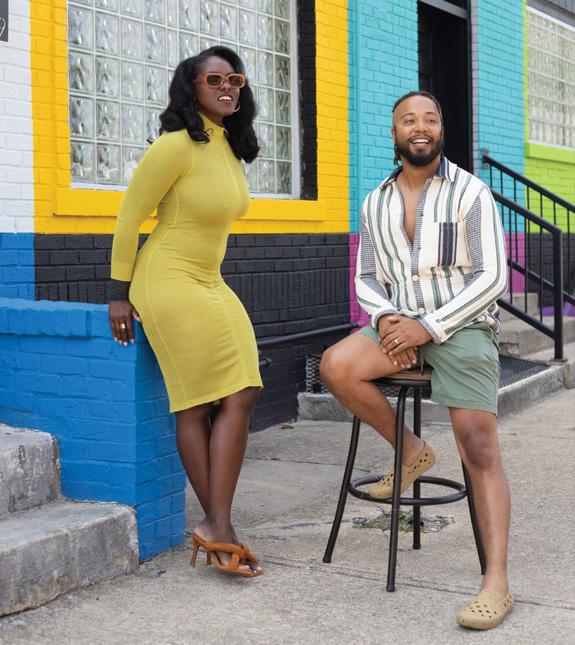
Hamilton’s milestone is the opening of Ozone, a subsidized, mixed-use building that now serves as an artist apartment and studio along with a separate exhibition hall. It is part of a larger creative care initiative, the B-Side Creative Campus, on Indy’s near eastside.
Malone’s milestone is the release of the Public Art for All census conducted and designed through Rokh. The team involved scouted more than 6,500 miles of roads and sidewalks to document, well, everything. From manhole covers that had been painted to murals, graffiti, statues, and roadside memorials.
This conversation captures a glimpse of what those experiences were like for these artists. You can’t actually hear the generosity of their laughter, but you may still catch the sweet tone of their friendship.
WALTER LOBYN HAMILTON: You just completed the most intense public art related project I've ever heard of. Can you share where you are now with the Public Art for All census and how you’re feeling being in the middle of your PhD program, and the ninety million other things you’ve got going?
DANICIA MONÉT MALONE: I feel really hopeful to be honest. It was a year-long project. And in totality it was probably closer to a year and six months, because we spent a lot of time researching and a lot of time creating the framework for how we were gonna approach it. 'Cause like you said, it was ambitious. We wanted to scout all of the public artwork. Even just saying that I wanna slap myself.
But now I feel good. I'm glad that it's out. I'm glad that it's being used. I love the questions and the feedback that we're getting about it. Most folks are saying, ”I've never seen anything this comprehensive." That's the first thing that they say, every time.
It's not a normal compliment, but I take it as one. The whole team really wanted to be thorough, to not
leave anybody out. That's kind of the practice you and I have talked about–the practice of being a good person, of being an intentional artist. We were being intentional as a team and challenging what true equity means.
WLH: Now that everyone's absorbing this data, what do you think people have missed in viewing the report? Is there anything that you would like to emphasize about the work that was, in my opinion, done in such a tremendous fashion?
DMM: I think people missed the sheer massiveness, in terms of the geography we covered, because we looked at the whole county. The entire Marion county and not just Indianapolis, which we conflate a lot, thinking that Indianapolis is the county.
WLH: I did too, until I saw your map.
DMM: Yeah. It's a common assumption, so I hope that people will keep reminding themselves that the data is bigger than just Indianapolis. We looked at Lawrence. We looked at Beech Grove. We looked at all of the small cities and towns. I think it was fifteen in total that make up Marion county. So we didn't demarcate ourselves by saying, “This is where the Indianapolis border ends.”
Because we went county line to county line, we were able to identify public art deserts, which I'm very proud of. Now we can define them in a way that makes it approachable for people to think this area might be a space where folks are trying to have more aesthetic representations of themselves, or of their experience, and to ask what's missing. Do they not have funding? Do they not have support? Do they not have resources? Are they not given access to vacant property?
WLH: What was one of the most surprising moments or data points you went through that you were like, “Holy shit?”
DMM: The biggest aha for me was to witness the ways that churches and daycares have some of the most beautiful art. It's like they were the origins for neighbors to understand that they can beautify and paint and have creative interpretations.
How about you? You’ve now designed a campus totally focused on the wellbeing of the creative community. How does that feel? What's something that you’ve had an aha about?
WLH: I think it went from one side of creative care to a completely different side of creative care. At first you want a big structure, and that's what I began to
really focus on because I believe that was the most difficult thing to do in the neighborhood. Not having support earlier on financially, when you're up against gentrification, you're up against people that have more resources and connections.
I acquired as many parcels as possible, before they got priced out. Now I’m thinking, “How else can you take care of creatives past the point of that physical structure?” Do they need behavioral therapy? Do they need... Do we need a nutritionist? Do we need funding? Do we need loans? Do we need... financial counseling? Thinking about how you can impact the creative person outside of giving them support to simply create more. That's the hard thing, right? There's an expectation to flip that, show metrics, et cetera. I'm there right now. I’m like, “Who am I as an artist if I'm not making, creating, or doing something for myself or other people? Can I take that moment to do those things for myself?” You feel like you can't. Then maybe it's a little bit better if someone intercedes on your behalf and says, "Here's a free membership to Kan-Kan or North Mass Boulder.” Or, “I just came from A Place to Float. You can go there, and I'm not gonna give you money so you can go do that. I'm just gonna provide the actual thing, so it makes it a little bit easier for you to invest in yourself.” To counteract the sense that everything's output, output, output… As artists, we're gonna need a lot more for ourselves than we realize.
How about you? Where are you at now? And where are you going next? Holistically as a person, and also you as an individual, in terms of your output.
DMM: Holistically, I just want to take care of myself. The same things that we've been talking about around B-Side. I’m asking myself, “How do I practice that? How do I model that?” That's where I am. I'm fasting. I'm detoxing. I'm waking up at 7:00 AM and going for a morning walk. Meditating. Putting oil on my nails. It's the little practices. I just want to feel good. Professionally, I don't know that I have an answer for that right now, because I guess I just want to dream. I've always felt like I had to have the answers–and out of habit I could rattle off five goals. But I want to take a break from that.
WLH: Yeah, man, I'm glad you said that. That's true.
DMM: I just think it’s straight up wisdom. How about you?
WLH: What am I gonna do? So I think it's the same thing. I usually know where I’m gonna go next. It's like Bob Marley said when he got shot, he said, “The people that are making the world bad don't take a day off.” But I'm like, "No, I'm sure the brother took some

days off, and he was still living a way that also helped him to get back up."
I think it's creative care. It’s the wisdom of saying, "I don't know how the hell to get there, or this may be wrong, or this may not catch all the nuance of a thing.” I'm very excited about the opportunity to discover what comes out of that mindset. I’m grateful for the opportunity to be in that space, to have time and to think, to meditate, and to be right and be wrong and everything in between, and still be able to say, "Okay, now what?" And, man, that's bliss. ✂
For more on these projects, visit: bsidecc.com and rokh.co.
We were being intentional as a team and challenging what true equity means.”

has lived in Indiana since the age of three. From an early upbringing in Bloomington to grade school in Indianapolis and an eventual education in South Bend at Notre Dame, Samba’s Hoosier roots are as deep as one can get. Having held a career in Division One soccer with the Fighting Irish and corporate roles with the Pacers and Fever Basketball, one might assume his passion for championing Indiana peaks with athletics. On the contrary, Samba has cultivated a career now steeped in the greater creative economy by cheering on the digital footprint of artistry with his startup, COSA NFT.
Samba launched COSA with co-founder Joe Copeland in 2020. The idea was born from a desire to restore power to musicians disenfranchised by the global pandemic. What began as a mission to supply music artists with their own virtual venues expanded into a variety of creative disciplines, such as providing fine artists with digital art galleries and creating exclusive experiences to build community amongst fans. No matter the medium, COSA offers a unique value proposition for creators seeking to capitalize on the technological advancements shifting our creative landscape.
In an exclusive interview with the dynamic entrepreneur, we unpack how the teamwork of artistry and technology is championing a more profitable future for creatives.
Non-Fungible Tokens (NFTs) have been around for almost ten years, but they are often misunderstood to be complex because of their proximity to more elusive concepts like the blockchain. In simplest terms, you can consider an NFT to be the artwork—or any product that can be digitally manifested—and the blockchain is the receipt for purchasing the artwork that cryptocurrency is recorded on. It is important to note that not all NFTs require cryptocurrency to purchase. COSA joins the minority of NFTs offering both a tangible product and non-cryptocurrency restricted transactions.
In Samba’s own words, “To be able to spend the kind of money that people are spending with NFTs and to have nothing to really show for it was kind of a miss. We believed we could fill the gap and solve that problem.”
The resolution? A physical card that artists can distribute to their fanbase, which not only shares the digital asset but also curates a virtual experience to personalize the customer journey. Notably, Samba procured his customer journey model through insight from his impressive career as a user experience designer. Having led a team at Angie’s List and holding positions at DeliverEnd and Salesforce, it should come as no surprise that the expert had thorough critique of the NFT customer journey.
“I focus on understanding how people experience these products and enjoy them . . . I saw a lot of problems with the current process,” Samba says. “Purchasing NFTs is difficult. I’m a tech person
myself, and I had difficulty diving into purchasing them, setting up crypto wallets. I lost some money myself off that.”
COSA’s product makes the process easier, giving artists and musicians an opportunity to distribute their music directly to their audience without having to go through platforms like Spotify, Apple Music, or YouTube. When fans purchase their artist’s token, they receive a physical certificate of authenticity and a unique Near Field Communication (NFC) card providing direct access to the content.
Tamba explains the virtual reality presentation of the asset is the common “front door” experience, while iterations of usage are exhaustive. One might put it in a frame or up on a wall to look at, but it offers real utility. The digital asset—the song, the image, the video, the GIF, whatever you purchased— it will take you directly to that so that you can enjoy it.
Consider the next time you are visiting an art gallery straining your eyes to read the artist’s name and work description on a small placard. Wouldn’t it be nice to view a video of the work being created, the artist telling the story of what inspired it, or a personalized message of gratitude? An NFC-enabled product can transport you to a virtual-reality experience.
For creatives seeking global exposure, the distribution of such a product can broaden the domain for admiration beyond the confines of a local gallery. Producers of tangible arts, like illustration, can share unpublished works with their followers. Musicians can share unreleased music or private concerts. The options are as limitless as the imagination of the creator. COSA NFT’s ability to offer mobility to artists is championing the future of creative technology in the Midwest. ✂


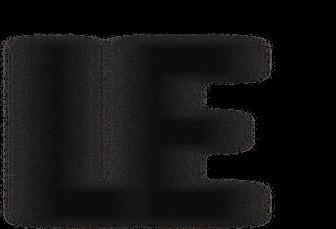 PHOTOGRAPHY BY CECIL MELLA
STYLE BY MEGAN LUTES & EMILY BOUCK
GROOMING BY INDIA HALL (AESTHETIC ARTIST AGENCY)
MODEL MITCHELL R. (10 MGMT MODEL AGENCY)
SPECIAL THANKS TO ZODIAC VINTAGE
PHOTOGRAPHY BY CECIL MELLA
STYLE BY MEGAN LUTES & EMILY BOUCK
GROOMING BY INDIA HALL (AESTHETIC ARTIST AGENCY)
MODEL MITCHELL R. (10 MGMT MODEL AGENCY)
SPECIAL THANKS TO ZODIAC VINTAGE









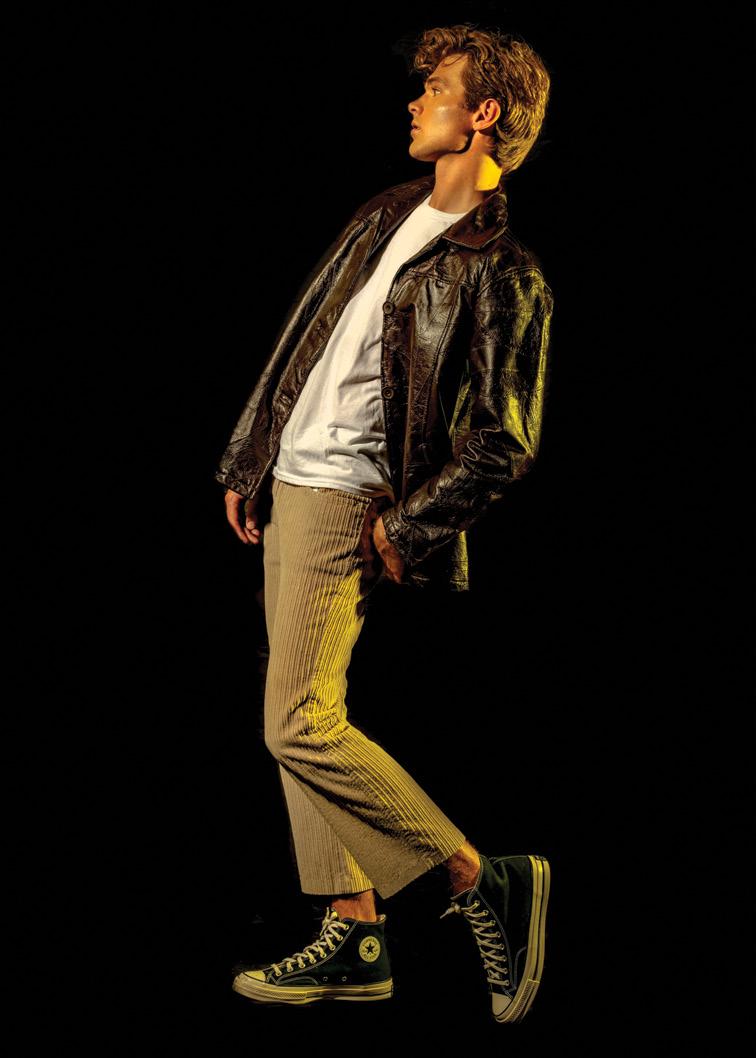


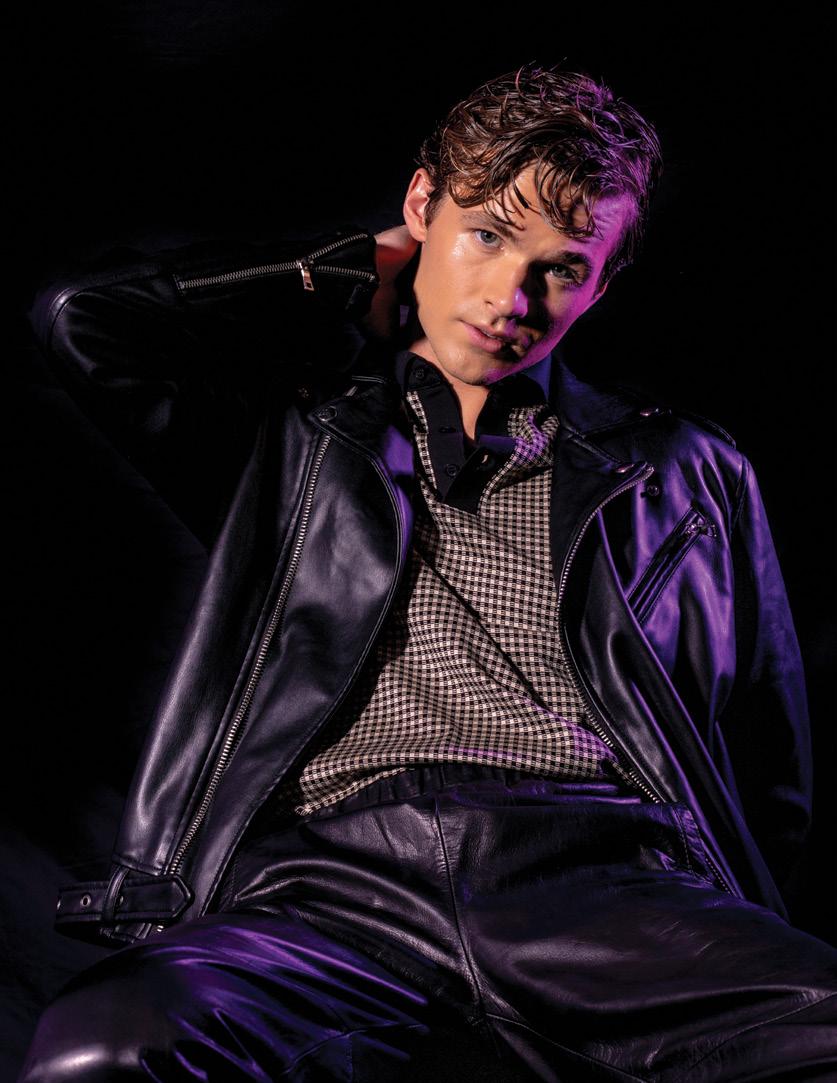


 DRESS HOUSE OF XIONG CREATION, WIDE WHITE BELT VINTAGE GAIL LABELLE, STYLIST'S OWN, THIN WHITE BELT J CREW, THE TOGGERY RESALE, BOOTS MODEL'S OWN
DRESS HOUSE OF XIONG CREATION, WIDE WHITE BELT VINTAGE GAIL LABELLE, STYLIST'S OWN, THIN WHITE BELT J CREW, THE TOGGERY RESALE, BOOTS MODEL'S OWN
 DRESS RICK OWENS, KIMONO VINTAGE, STYLIST'S OWN, SHOES SEE BY CHLOÉ, THE TOGGERY RESALE, LAYERED NECKLACES VINTAGE, THE TOGGERY RESALE
DRESS RICK OWENS, KIMONO VINTAGE, STYLIST'S OWN, SHOES SEE BY CHLOÉ, THE TOGGERY RESALE, LAYERED NECKLACES VINTAGE, THE TOGGERY RESALE
JACKET ALIA HOODED MESH, STYLENSPIRE, PANTS ALIA MESH, STYLENSPIRE, CAPE STYLENSPIRE, BELT VINTAGE, STYLIST’S OWN, BOOTS MATISSE, CATY BOOT



 COAT NORMA KAMALI, BOOTS ALEXANDER WANG ALDRICH BOOT, NECKLACE THE TOGGERY RESALE
COAT NORMA KAMALI, BOOTS ALEXANDER WANG ALDRICH BOOT, NECKLACE THE TOGGERY RESALE
VEST QUILTED MILITARY LINER VEST, ZODIAC VINTAGE, BELT FRAME, THE TOGGERY RESALE, SKIRT RICK OWENS LACQUERED DENIM PILLAR MAXI SKIRT, SHOES MIX
 NO. 6
NO. 6
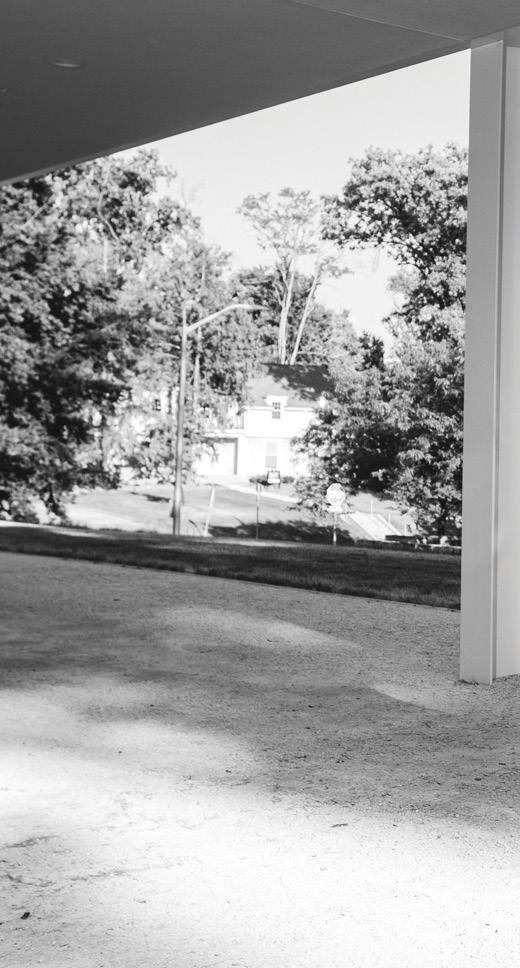
 WHITE SHIRT DRESS DRIES VAN NOTEN BLACK DRESS, SQUARE NECK MIDI DRESS COMME DES GARCONS, SOCKS MEMOI SHEER POLKA DOT SOCKS, SHOES JEFFREY CAMPBELL XANDRA PLATFORM PUMP
WHITE SHIRT DRESS DRIES VAN NOTEN BLACK DRESS, SQUARE NECK MIDI DRESS COMME DES GARCONS, SOCKS MEMOI SHEER POLKA DOT SOCKS, SHOES JEFFREY CAMPBELL XANDRA PLATFORM PUMP
You still have the expansive windows, but because you're elevated, it has the feeling of floating. It's hard to put into words – you’re a part of the campus, but you're also separate from it. And it's really interesting to watch people walking by and how they interact with the building. They are looking at me and will wave!
AT: You obviously have a career that's been based in the design professions. How do you think that background gives you a special sense of this building?
PF: As I studied its architectural history, I think that, given my background, I appreciate it and understand the significance. And there is a sort of weaving of stories, between the Republic Building in Columbus and this building and an Indiana landscape that feels like a connector across that space of 35 miles between Bloomington and Columbus.
In 2021, Indiana University built a “lost” design by Mies van der Rohe, the pioneering German-American modernist architect. Commissioned in 1952 by the leaders of a fraternity, the vintage design languished for lack of funding. But with support from philanthropists Sidney and Lois Eskenazi, the instantly iconic building is now the hub of IU’s Eskenazi School of Art, Architecture + Design.
What follows is a conversation between Peg Faimon, Founding Dean, Eskenazi School of Art, Architecture + Design, and Adam Thies, Associate Vice President, Capital Planning & Facilities at IU — on design education, problem solving, and Indiana’s modernist legacy.
ADAM THIES: Not many people get to sit inside a newly built Mies van der Rohe building that was designed 70 years ago. What's it like to come to work every day?
PEG FAIMON: It’s a lovely space – very light and airy. I talked with my staff about working in this building and they really enjoy the atmosphere and find it inspirational. And I think that it allows you to feel like you're part of the campus. The building is just elegant.
AT: The Eskenazi School’s Columbus campus occupies the former Republic Newspaper Building, another white-painted steel-and-glass modernist icon. How is this different?
PF: Maybe because I'm used to the Republic Building and how that feels, this building is completely different.
I love the details of the Mies building. And I appreciate them in ways that somebody who doesn’t have that training might not be— to see deeply and to look beyond just the everyday. It’s the fact that nothing is hidden and everything's exposed — it feels like a very honest space.
AT: You are an alumna of Indiana University in the 1980s. What is different from when you were becoming grounded in the design profession versus what is happening today in the way that your school is teaching the topic of design?
PF: Back in the 80s, design was taught in a very specific manner and the disciplines were fairly well separated from each other: architecture, interior design, fashion design, graphic design. I definitely thought of myself at that time as a graphic designer, not as a designer more broadly. And then when I went to Yale, it was again, focused. So in my first year of teaching, I team-taught a class with marketing and communications professors. It was like moving from design with a “small d” to design with a “capital D,” designing larger and broader systems. Where you're really thinking about how design itself can solve major problems of the world. That is what we are trying to do here at the Eskenazi School: teaching the connection to other disciplines and problem-solving at a larger scale and how design can impact the world…from the beginning of the process.
AT: Mies was the last director of the Bauhaus in Germany in the 1930s, and the chair of the architecture program at Illinois Institute of Technology in Chicago in
the 1940s and 1950s. Both were very integrated design educations. When you think about the Bauhaus [the unification of art, craft, design], how do you think that relates to where you are now?
PF: I do think there's an interesting connection, and I think design education got away from the style of the Bauhaus for some time. We got away from the connectedness that once existed. And we siloed ourselves into these places. Part of that was, I think, the disciplines growing themselves as unique entities and trying to establish their own voices, their own identities as disciplines. They're seeing the value of coming back together.
AT: The world needs problems solved, right?
PF: Yes, and they must be solved in a collaborative manner. And that includes disciplines beyond the design disciplines. And goes beyond even the Bauhaus philosophy: to informatics, to engineering, to science.
AT: Like design thinking showing up in business schools, right?
PF: Yes, getting ourselves to this idea of a more unified “Capital D” design.
AT: What do you think a graduating student might say about their experience at the Eskenazi School, ten years from now?
PF: I hope the education we provide now and in ten years provides the foundation, the springboard into a career with strength of discipline, but also strength of breadth. I would hope that they would say that it prepared them for a lifetime of curiosity, of wonder, of passion. ✂
"I HOPE THE EDUCATION WE PROVIDE NOW AND IN TEN YEARS PROVIDES THE FOUNDATION, THE SPRINGBOARD INTO A CAREER WITH STRENGTH OF DISCIPLINE, BUT ALSO STRENGTH OF BREADTH."
-PEG FAIMON

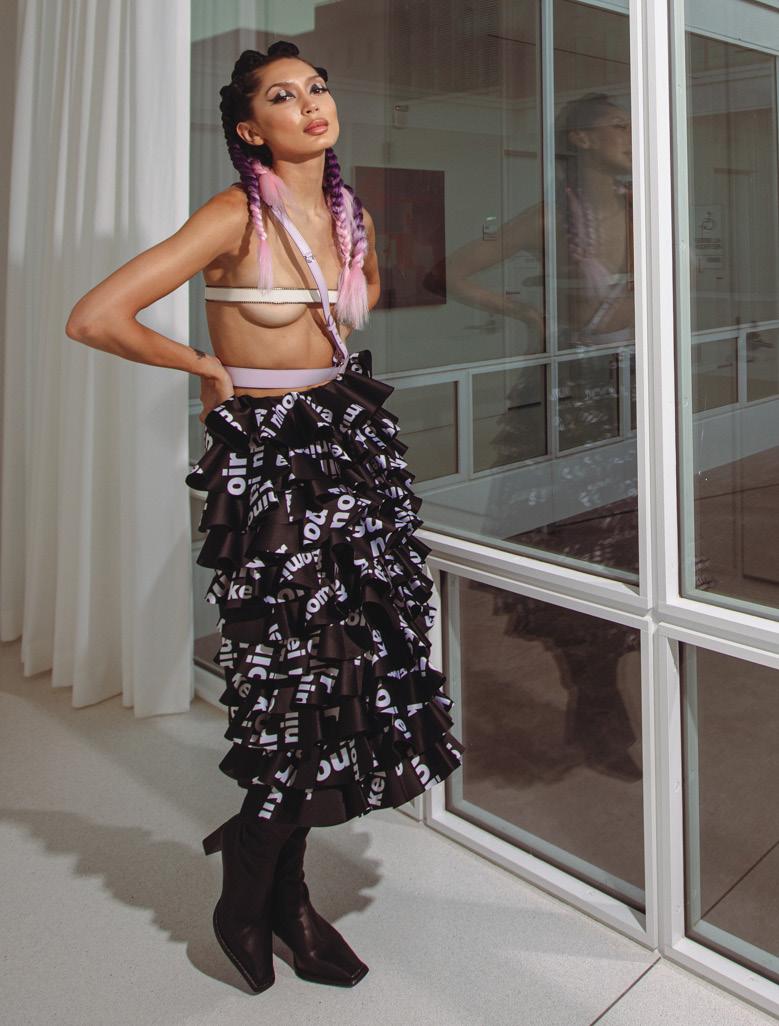


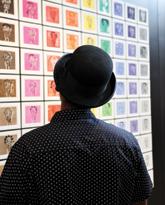



On Labor Day Weekend, the Indianapolis community came together like never before, all in the name of culture and the arts. BUTTER: A Fine Art Fair has sparked a shift in the cultural environment and mood of Indy, thanks in part to the 8,000 plus people who celebrated with us this year. If you were there, you know. BUTTER was a smashing success, breaking sales and attendance records all around. We are proud to report that 109 artworks sold during the four days, generating more than $250,000 of profit for the 42 local and national Black artists featured in the show. We are also happy to report that eight pieces were acquired by major institutions for their permanent collections. The amount of times we heard “BUTTER makes me proud of my city” was incredible, and so we say thank you. Thank you to our artists, performers, partners, sponsors, and friends. And thank you Indianapolis for helping to spread the BUTTER magic.


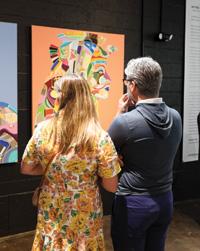



 -TEAM GANGGANG
-TEAM GANGGANG
TITLE SPONSOR
AES Indiana
PRESENTING SPONSOR
JPMorgan Chase & Co.
TOP SPONSORS
Allen Whitehill Clowes Charitable Foundation
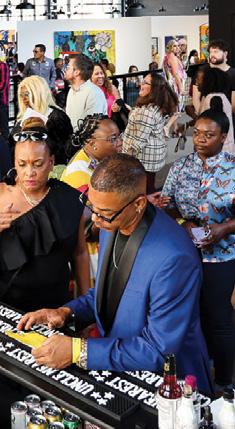
The Indianapolis Foundation
OneAmerica
ADDITIONAL SPONSORS
Barnes & Thornburg
Black Onyx Management
Browning
Buckingham Companies
Buckingham Foundation
Elements Financial
Eskenazi Health
Griffith Family
Herron School of Art + Design IUPUI
Indiana University Health
Indy Arts Council




Kite Realty
Mays Chemical
Maywright Property Co.
Meridian Foundation
NFP
PNC Bank
Rachel Simon and Jennifer Simon
SomeraRoad
The National Bank of Indianapolis
Visit Indy
IN-KIND SPONSORS
Amelia's
Ash & Elm Cider Co.
AGT Catering
Birdie Brown
CityWay
Conrad Indianapolis
Indianapolis Recorder
IndyGo
Newfields
OUTFRONT Media


Pivot
Sip & Share
Solid State
Sullivan’s Hardware
SunKing
Uncle Nearest
Where’s Mike G?
AH, 2022. WHEN THE PAST IS HOTLY CONTESTED, AND THE FUTURE is existentially threatened (or at the very least uncertain). Even the young and beautiful* believe “societal collapse is in the air.” What, then, do we make of the present? For those whose job it is “to make,” how is this moment being processed and made meaningful?
FROM MY PERCH, I SEE A TIME RICH WITH ACTIVITY, IDEATION, CREATION, and production. After the isolation and stagnation of early Covid, life haS spilled out of its confines, eager to circulate, mutate, and be in communion with others. I see an art world that is more diverse and open than it ever has been before (not saying much, but still). I see an audacious fashion universe with few rules, if any. I hear music that is ever more global, heterogenous, and inventive. The practice of poetry is increasingly inclusive and capacious. Dance unfolds on ever expanding platforms, both physical and virtual. Film is everything, everywhere, all at once.
ART—WRIT LARGE—IS BOOMING AND BUSTING AND CRACKLING WITH ENERGY.
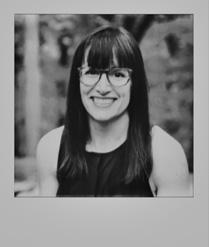
THE INSTITUTIONS THAT RUN OUR OVERLAPPING WORLDS OF ART ARE BEING FORCED TO CONFRONT THE SYSTEMS of power and influence that have long determined which artists are considered “great.” Attempts to correct the wrongs of the past battle against forces adamant to maintain the narratives of old. Confrontation is afoot.
ARTISTS AND APPRECIATORS ARE HUNGRY FOR CONNECTION AND EXCHANGE. WE ARE IMPATIENT FOR meaningful, lasting cultural change, grappling with the simultaneous urgency of need and the understanding that it could take time. In a time of TikTok, quarterly reports, and election cycles, long-term planning is an idea that feels foreign, even subversive. I’m hopeful that our goldfish tendencies, flitting around the bowl, can transform into powerful school-of-fish tendencies, assembling and collaborating toward progress.
THIS FALL I’M IN THE MOOD FOR SCHEMING, MANEUVERING, AND INCREMENTAL CHANGE. I WANT TO THINK about the structures and experiences I wish existed, and take steps toward making them real. This doesn’t imply forsaking the present, but rather making space for better futures. Let’s hold meetings and events, construct mock-ups, and lay the groundwork for more lasting interventions.
WITH TIME, THE CREATIVE FLOW OF 2022 COULD BE REMEMBERED AS THE BEGINNING OF A NEW ERA FOR ART —a more equitable, impactful creative landscape.




